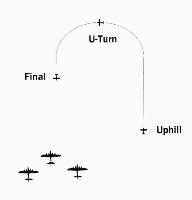
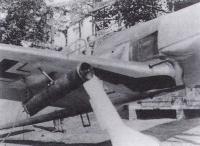

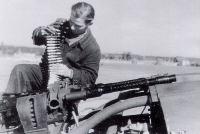
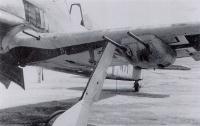


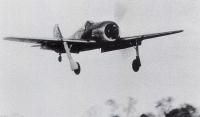
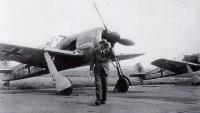
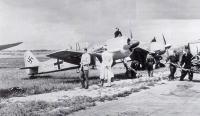
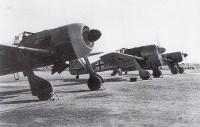
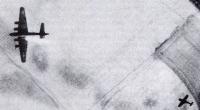
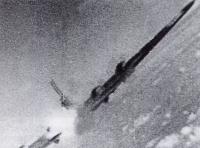
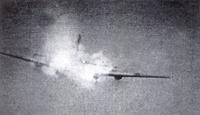
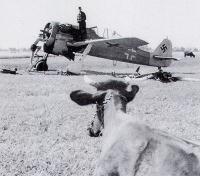
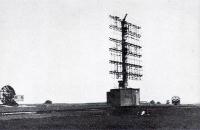
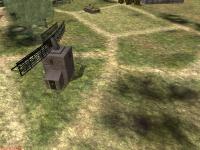

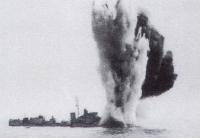
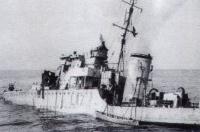
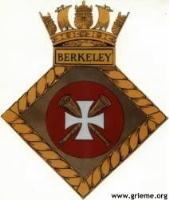
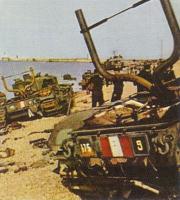

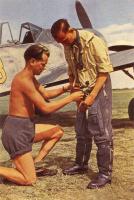
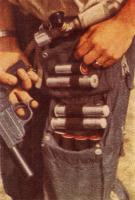
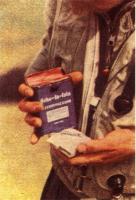
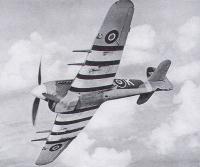
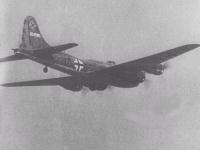

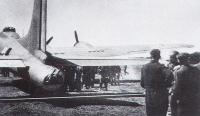
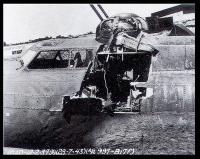
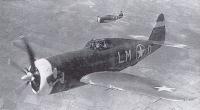
 |
 |
 |
 |
 |
 |
 |
 |
 |
 |
 |
 |
 |
 |
 |
 |
 |
 |
 |
 |
 |
 |
 |
 |
 |
 |
 |
 |
 |
 |
 |
 |
HOLDING THE WEST"I was only able to leave the Western Front so completely uncovered because I had two such outstanding Geschwader to leave behind." Reichsmarschall Hermann Goring, 5 December 1941 "When you look at how we fought against the Americans later, the Battle of Britain was very little in comparison." Post-war comment by Julius Meimberg, formerly Staffelkapitän of II./JG2 "Opening fire from behind at 300 metres distance, and taking five to six seconds to overtake the bombers, these attacks were indescribable in their sheer physical and mental stress. Just imagine standing under a shower with 160 jets of water pouring out and not getting wet! That, of course, is quite impossible. Even when we attacked with four [aircraft] in line abreast in an effort to split up the defensive fire, statistically there were still 40 guns firing at each one of us. " Otto Stammberger, formerly Oberleutnant and Staffelkapitän of 4./JG26, describing rear attacks on US four-engined bombers. The Channel Front in mid 1941: In late June 1941, following the departure of units eastwards in preparation for Operation 'Barbarossa', the German invasion of Russia, only two front-line day fighter Jagdgeschwader remained in Northern France and Belgium; JG2 'Richthofen' and JG26 'Schlageter'. These units were responsible for the daylight defense of occupied north-west Europe from Belgium to the Bay of Biscay and had been intentionally left in the West because of their previous experience and success. Although they were outnumbered by the RAF and their area of responsibility was large, unit morale was high. Pilots had recovered from the strain of the battles of 1940, most Gruppen possessed a superb fighter in the Bf-109F, and pilots knew that if they were shot down over France, their chances of survival were now far greater than when they had fought over Southern England and the Channel the year previously. On 1 May, JG26 had achieved its 500th aerial victory and JG2 'Richthofen' was only days away from celebrating its 644th victory, the same number as achieved by Jagdgeschwader Frhr. von Richthofen Nr. 1 during the First World War. Both units were about to enter their most successful phase of the air war, and between them had an establishment of 236 aircraft, although JG26 lacked its 7.Staffel which was in the Mediterranean and II./JG26 was soon to be withdrawn to exchange its Bf-109E-7s for the new radial-engined Fw-190. While JG2 and JG26 held the Channel coast, other front-line day fighter units on the Western Front, excluding Norway, were I./JG52 in Holland with an establishment of 40 aircraft, and parts of I./JG1 with an establishment of 28 aircraft. Only formed in June 1941, I./JG1 was based at various airfields for the defense of Northern Europe but, as units based in Holland moved to other fronts, JG1 covered that area too. Finally, there was a number of Einsatzstaffeln, or Operational Training Squadrons, which, nominally at least, had an establishment of 48 aircraft, but their role was limited and they were not truly front-line units. Apart from these fighter units, the only other forces remaining in France after the invasion of Russia were those engaged in the night bombing of Britain or those flying anti-shipping and reconnaissance missions. Although Luftwaffe units in the West therefore amounted to little more than a token force, they proved to be extremely effective in holding down in Britain a considerable number of fighters which, at the time, could have been employed in the Mediterranean theatre. Moreover, the Luftwaffe's numerical disadvantage was to some extent offset by the establishment in France of an early warning radar system, although no fighter control service had yet been set up which could locate and vector German formations onto the enemy force. Generally, the German system worked well although it was affected by bad weather, and on one occasion, when a force of 54 Blenheim light bombers mounted a daylight cloud-cover raid on power stations near Cologne, the defenses were completely unaware of the attack until bombs fell on the targets. The early RAF offensive missions into occupied Europe were at first designed merely to maintain a constant pressure on Luftwaffe forces in the West and to draw up German fighters where, it was hoped, they could be destroyed in a war of attrition. However, with the German attack upon Russia in June 1941, such efforts acquired additional importance and Fighter Command's offensive operations then became an integral part of a policy of affording assistance to the Russians. By intensifying operations, it was considered possible not only to hold down in north-west France a large German fighter force which otherwise could have been usefully employed on the Eastern Front, but also to force the Luftwaffe to withdraw units from the East in order to strengthen its fighter defenses in France. Following the invasion of Russia, there was therefore a marked increase in the number of RAF missions flown to attack targets in France. Most British formations consisted of about 25 bombers with three times as many escort fighters, but sometimes formations with as many as 80 bombers and a proportionately larger escort were encountered with the escorts tied to the bombers in much the same way as were the German fighters in the Battle of Britain. The RAF bombers' altitude was usually about 21,000 feet and, typically, the German fighters, maintaining radio silence, would climb to a position above and behind the British formations. When contact with the incoming formation was made, the German formation leader broke radio silence to place his formations in the most tactically advantageous positions before diving through the British fighter escort to attack the bombers. In view of the risks associated with this kind of attack, it was at this time that Oberstleutnant Adolf Galland, Kommodore of JG26, and the members of his Stabsschwarm, devised another method of attacking the British formations. Using cloud cover, the four fighters gradually infiltrated the RAF formation, making no sudden movements that would attract attention. Once the fighters were well placed, Galland would select a convenient part of the bomber formation at which to strike, lead his Schwarm in to the attack and then dive away before the escort could react. These tactics proved successful on a number of occasions. A second and similar tactic developed by Galland called for the attacking fighter pilot to fly alone in order to be successful. In this manoeuvre the pilot would climb slowly out of the clouds beneath a bomber formation while other German fighters occupied the attention of the fighter escort by conspicuously positioning themselves high in the rear of the British formation as though preparing for an attack. If he remained unseen, Galland was often able to position himself behind one of the lower elements of the bomber formation and make a successful attack before diving away. However, as this form of attack required a low approach speed in order to be effective, it was regarded as very dangerous and he depended on a quick dive into the clouds for escape if discovered prematurely. RAF 'Circuses' [1] were now occurring almost daily, sometimes with more than one attack taking place each day. On 8 July, for example, a raid in the morning was directed against Lens, and Lille was the target in the afternoon. Fighter Command actually lost 13 Spitfires during the day, but Luftwaffe fighter claims initially totaled 21. Evidently, it was realized that there was some overclaiming and not all claims were confirmed, but the pilots of JG2 'Richthofen' were eventually credited with seven victories, bringing the Geschwader's total to the 644 required to equal that of its First World War namesake. During the day, Lt. Egon Mayer of 7.Staffel, who had received the Ritterkreuz a week earlier, claimed four Spitfires and a Blenheim, while Oblt. Josef Priller, Staffelkapitän of I./JG26 claimed a Spitfire as his 34th victory. One particularly successful pilot was the Staffelkapitän of 9./JG2, Oblt. Siegfried Schnell, whose three victories brought his personal score to 40 and earned him the award of the Eichenlaub. Schnell, already at this time one of JG2's highest-scoring pilots, again distinguished himself on the 9th when the RAF sent a 'Circus' to Marzingarbe. On this occasion, early Luftwaffe claims were for 17 Spitfires against an actual loss of eight, but all six Spitfires claimed by Schnell were confirmed. On 14 July, Oblt. Priller shot down a Spitfire near Dunkirk as his 40th victory and was awarded the Eichenlaub. Four days later, Fw. Ernst Hickel of 2./JG26 became the first of the Luftwaffe's day fighter pilots to destroy a four-engined bomber, a Short Stirling brought down off the Kent coast. This, Jackel's sixth victory, earned him a reward of 500 Reichsmark and a special trophy. Another leading ace at this time was Hptm. Hans 'Assi' Hahn, Kommandeur of III./JG2, who was awarded the Eichenlaub on 14 August after achieving 42 victories and who would eventually claim a total of 68 in the West before being given another command on the Eastern Front in mid-November 1942 where he claimed a further 40 victories. Another well-known pilot flying with JG26 at this time was the Kommandeur of III./JG26, Major Gerhard Schöpfel, who had been one of the most successful pilots during the Battle of Britain. On 21 August he accounted for one of the 14 Spitfires lost that day, bringing his total to 33 victories. A number of JG2's pilots also made claims, including Major Oesau and Lt. Mayer, each of whom claimed two Spitfires. Also claiming two was Ofw. Josef Wurmheller who, at the end of the Battle of Britain, had four victories and had survived, being twice shot down in the Channel. After a period in hospital, he had returned to his unit, JG53, and claimed 9 victories in Russia before being transferred to the West and joining II./JG2 at the end of July. During the following months, Wurmheller would develop into one of the RAF's most dangerous adversaries on the Channel Front. The Consequences of an Interrogation: On 10 July, Hptm. Rolf Pingel, the Kommandeur of II./JG2, intercepted a number of RAF Stirling bombers returning from an unsuccessful mission and followed one to the British coast. According to Pingel, before he could open fire, and possibly as a result of defensive fire from the bomber, the engine of his aircraft failed and, selecting a suitable landing place, he crash-landed his Bf-109F-2 at Deal, in Kent, where he was taken prisoner (ADD LINK!!!) (See Volume 2, Section 4, Pages 380 and 381). As a Ritterkreuzträger with 22 victories, Pingel was an important capture and his subsequent interrogation over the next few weeks was to have interesting consequences, particularly in relation to the RAF's offensive policy. At that time, claims by RAF pilots had led Fighter Command to believe it was inflicting serious casualties on the Jagdgeschwader in France, yet the German fighter force was still able to take to the air in strength. So far as was known to the RAF, the Jagdwaffe had not been reinforced by any fresh front-line units from elsewhere, so how could they possibly continue to maintain such strength if it had really suffered the high losses RAF pilots were claiming? Pingel maintained that it could not, stating that such high losses as were being claimed by the RAF would not only have represented the destruction of half the total available fighter strength in France, but that the Luftwaffe would have been quite unable to make good such high wastage. In view of the sustained German fighter strength in France, the RAF drew the obvious conclusion: Fighter Command was not, in fact, inflicting the casualties its pilots claimed. Pingel's statements also clearly indicated that the aim of inducing the Luftwaffe to move its forces from east to west had not been, and was not likely to be, achieved. Moreover, they revealed that the daylight offensive was resulting in much heavier casualties to Fighter Command than to the Jagdwaffe. Consequently, following a conference on 29 July to review the situation, the RAF decided to reduce the intensity of its offensive. The RAF, however, had failed to realise that, overall, its offensive had not in fact been entirely without effect. When it had begun, German serviceability stood at 73 per cent, but as a consequence of the increased wear and tear on aircraft, by August, a month after Pingel's capture, this had dropped to 70 per cent. Thus, at the very time the offensive was beginning to have some effect, the RAF decided to reduce the intensity of its offensive. Soon the two Geschwader were as strong as they had been in the Spring and, by September, serviceability had increased still further to 81 per cent. The first Fw-190 combat loss occurred on 18 September when the Kommandeur of II./JG26, Hptm. Walter Adolph, then with 25 victories and a holder of the Ritterkreuz, was shot down by a Spitfire during a dogfight over the Channel. His body was later washed up on the Belgian coast. Adolph was replaced by Joachim Müncheberg whose 7./JG26 had recently returned from the Mediterranean theatre where, during a seven month period of operations over Malta and Libya, the Staffel's pilots had claimed 52 aerial victories without loss before rejoining III./JG26 at Ligescourt to re-equip with the Bf-109F-4. On 29 August, Müncheberg had claimed a Spitfire as his 50th victory, and the day following the death of Hptm. Adolph, Oblt. Müncheberg was promoted to Hauptmann and given command of II. Gruppe. Another successful pilot on the Channel Front in 1941 was Oblt. Johannes Schmid who flew with the Geschwaderstab of JG26 and claimed his 24th victory on 24 August, for which he received the Ritterkreuz. At the same time he was promoted to Hauptmann and became Staffelkapitän of 8./JG26. Hptm. Schmid claimed his 30th victory on 7 September and continued to increase his tally, sometimes with multiple kills, and claimed two Spitfires on 21 September, three on the 27th and another three on 3 October which brought his score to 40 victories. On 27 September, the whole of JG2 and JG26 with an establishment of 248 aircraft, were in Northern France; I./JG52, still with an establishment of 40 aircraft, remained in the Low Countries; and the Geschwader Stab and I./JG1 were in Germany with an establishment of 44 aircraft. The Geschwader Stab and I./JG53 had arrived in the Low Countries from the Eastern Front in September to replace JG52 which then moved to Russia in October. In mid-October, Stab and I./JG53 were joined by II./JG53, but operations mainly consisted of coastal patrols and were largely uneventful. However, on 25 October, a flying accident resulted in the loss of the Kommandeur of I./JG53, the celebrated escaper and Ritterkreuzträger Hptm. Franz von Werra. The 21-victory ace took off from Katwijk on a routine flight but disappeared when his aircraft inexplicably dived into the sea. He was eventually replaced by Major Herbert Kaminski. By mid December, the last parts of JG53 had departed for the Mediterranean and its area of operations was taken over by JG1. Meanwhile, the Jagdwaffe continued to inflict high losses on the RAF's 'Circuses' and rendered them particularly costly. On 7 August especially, Fighter Command lost 14 fighters, followed by another 15 on the-19th and 21 August and 15 more on 21 September. A turning point finally occurred on 8 November when, during an RAF 'Circus' against Lille, pilots of JG2 were credited with ten Spitfires and JG26 with at least another ten. True Spitfire losses were 17, but the operation was nevertheless considered too costly and, in view of the earlier losses and the additional problem of deteriorating weather and shorter days, the RAF Air Staff decided to restrict the scale of Fighter Command's operations. By this time, operations were in any case unlikely to affect the situation in Russia and the growing demands from other theatres of war called for a conservation of fighter resources which would not have been possible if the scale of operations was maintained at the level of the previous months. Occasional 'Circus' operations were still undertaken to keep the German defenses on the alert, but no more large, escorted daylight raids were attempted until the Spring and the main burden of the RAF offensive was carried out by small numbers of aircraft attacking shipping and fringe targets on as wide a front as possible. On 17 November, Generaloberst Ernst Udet, Generalluftzeugmeister of the Luftwaffe, committed suicide and the most highly-decorated members of the Luftwaffe, including Galland and Molders, were ordered to the state funeral in Berlin. Molders, then the Inspekteur der Jagdflieger, abandoned a tour of fighter units on the Eastern Front but was killed in a flying accident while returning to Germany. Almost immediately, Goring appointed Galland as Molders' successor and on 6 December, Major Gerhard Schopfel replaced the newly-promoted Galland as Kommodore of JG26. On 7 December, the Japanese attacked the American Pacific Fleet at Pearl Harbor and, four days later, Hitler declared war on the US. This action was later to have a far-reaching effect on the air war over occupied Europe, but for the time being it was clear that the Luftwaffe, although greatly outnumbered, had inflicted heavy casualties and the RAF fighter offensive had failed either to destroy a large number of German fighters or draw them from other, more important, theatres of war. Furthermore, the RAF had overestimated the effectiveness of the bombing of industrial targets and airfields and too high a proportion of Allied pilots had been lost in relation to German fighter losses. British claims were often still greatly exaggerated, the RAF claiming the destruction of 731 German fighters between 14 June 1941 and the end of the year, whereas the actual number destroyed according to German records was only 103. Moreover, this result was obtained at a cost of 411 Fighter Command pilots [3] so that for every aircraft that the RAF destroyed, it was losing on average four of its own pilots. Thus, at the end of 1941, the RAF's optimistic intention of inflicting considerable losses on the enemy by forcing him to fight when at a tactical disadvantage was far from being realised. Despite the Luftwaffe's success against the RAF, flying accidents and operational losses claimed some of its most experienced pilots. On 6 November, Hptm. Johannes Schmid of 8./JG26 accounted for his 45th victory, a Spitfire which plunged into the sea off Calais, and was circling the water where his victim had disappeared but was killed when the wingtip of his Bf-109F touched the surface and crashed. Similarly, on 22 December, five pilots of 6./JG26 were killed when they flew into a hill, one being the Staffelkapitän, Oblt. Walter Schneider who had 16 victories. German Fighter Counter-Offensives: Although the main efforts of JG2 and JG26 in 1941 were concentrated on defending the Channel coast, the return of more favorable weather at the beginning of 1941 allowed these units to resume the fighter sweeps and low-level fighter-bomber attacks which had been a feature of Jagdwaffe activity over Southern England in November 1940. However, whereas the main targets for the-1940 attacks had been RAF airfields, the new series of attacks was directed against coastal towns. These attacks, which became known as hit-and-run raids, were on a much smaller scale than those of 1940, and were usually conducted by one or two Schwärme (i.e. four to eight aircraft). No fighter escort was provided and pilots relied for protection on speed, surprise and their extreme low-level approach, but these tactics were extremely effective and presented the RAF with a difficult interception problem. This problem had still not been solved when, on 10 November 1941, Jafü 2 and Jafü 3 were ordered to put up one Jabo, or fighter-bomber Staffel from each of their subordinate fighter Geschwader, and the establishment of these specialized Staffeln marked the renewal of fighter bomber activity against Britain and coastal traffic in the Channel. The first of these units, Jabo Staffel/JG2, was formed in January 1942 under Oblt. Frank Liesendahl and was followed a few weeks later by the formation of Jabo Staffel/JG26 under Hptm. Karl Plunser. Both units were equipped with the Bf-109F-4jB fitted with a fuselage rack for four SC50 bombs or, more usually, a single SC 250. Pilots were sought who had gained some previous fighter-bomber experience in the latter stages of the Battle of Britain. As if to emphasise the problem the British defenses faced in intercepting low-level raiders in bad weather, two fighters had appeared off the Sussex coast on Christmas Day 1941 and opened fire on buildings at Fairlight near Hastings. This attack marked the real beginning of the low-level fighter bomber campaign of 1942 when the German fighter forces turned again to the offensive, and in the first three months of the year the fighters and fighter-bombers of JG2 and JG26 carried out 31 machine gun attacks against towns and villages on the South Coast. These raids, usually carried out at low altitude and often in conditions of poor visibility, were so difficult to intercept that in the same period the British defenses claimed only six aircraft destroyed overland by day. Moreover, the effort Fighter Command expended to intercept these raiders was out of all proportion to the damage caused. In the first three months of 1942, Fighter Command flew 4,677 interception patrols and 10,918 shipping patrols, yet the Luftwaffe, for the greater part of this period, still retained no more than a holding force in the West. On 3 January 1942, for example, the number of Luftwaffe bombers available for use against Britain was 274, and of these only 146 were serviceable. However, this small force more than justified its existence on military grounds as altogether, 1,478 aircraft, 6,000 guns and almost a million men and women of the Army and RAF stood by to meet the threat of air attack.[4] The German holding campaign in the West was, therefore, certainly meeting with some success and, for the RAF, the problems of intercepting the hit-and-run raiders essentially turned on the difficulty of providing adequate warning of its approach. The normal radar early warning station was limited by its visual range, but at the beginning of 1942 another type of special low-looking radar, known as Chain Home Extra Low, or CHEL, was being developed. By the beginning of 1942, the first-line establishment of JG2 and JG26 in France had increased by just 40 aircraft in six months. The whole of JG2 was still equipped 'entirely with the Bf-109F but the conversion of JG26 to the Fw-190 was well under way and with the exception of part of II. Gruppe and the Ergänzungsgruppe, the Geschwader had almost completely converted to the Fw-190. Further north, the defense of Holland and Northern Europe, including Norway, was entrusted to JG1 which, in January 1942, was increased to full Geschwader strength with the formation of II., III. and IV./JG1. At first, the area remained fairly quiet and JGl's first major action did not occur until the afternoon of 7 February when parts of the Geschwader intercepted a force of 32 Hampden bombers laying mines off the Friesian Islands. Three Hampdens were lost, all claimed by Ofw. Detlev Luth of 4./JG1, bringing his victory total to 29. JG1 was in action again on 12 February, when, together with JG2 and JG26, it provided aerial protection during Operation Donnerkeil, the so-called 'Channel Dash', when the Scharnhorst, Gneisenau and Prinz Eugen sailed up the English Channel from Brest to German ports. Operation Donnerkeil Protecting the Channel Dash: "..the weather actually occurred as forecast, even if it was about from six to eight hours late. But it saved us." Adolf Galland commenting post-war on the outcome of the Channel Dash. For most of 1941, the German battleships Scharnhorst and Gneisenau and heavy cruiser Prinz Eugen were all but stranded in Brest, where they were in constant danger from the RAF. To safeguard the ships and to protect Norway from any possible British invasion, Hitler ordered that the ships were to be brought back to Germany in a quick dash up the Channel. German preparations for the operation were excellent; passages were swept through minefields and marked so that the ships and their escort could sail at top speed, and permanent air protection was arranged with the Luftwaffe. The organisation and supervision of this fighter protection was one of the earliest responsibilities for Adolf Galland in his new position as General der fagdfliegel: The ships were due to sail under cover of darkness on the night of 11 February and the fighter protection, arranged under the code-name Operation Donnerkeil, was planned with such secrecy that even the leaders of the Gruppen involved were only made aware of the true purpose of the operation on the evening of the-10th. For the operation, Galland had at his disposal the full operational strength of the three western-based Jagdgeschwader - a total of some 250 single-engined fighters - plus a small number of Bf-110 night-fighters. As a reserve, 12 aircraft from the fighter school near Paris were mobilised and moved to the Pas de Calais where they were to be held ready should losses to the fighter force be greater than anticipated. Although the adverse weather forecast for the period would aid the escape, timing was crucial and the success of the fighter escort depended on three command centers established within separate Jafü boundaries parallel to the ships' course. Each centre controlled a succession of overlapping sectors in the English Channel and North Sea from Brest to the final posts of destination. To provide an element of local control, Oberst Max-Josef Ibel, the former Geschwaderkommodore of JG27, embarked on Scharnhorst with a signals detachment as Jafü Schiff. [2] The British response began some two hours later in the form of an ineffective salvo from the Dover gun batteries and was shortly followed by the first aerial attack when six Swordfish torpedo aircraft with an escort of 11 Spitfires was intercepted by the German fighters which also shot down all six of the Swordfish. Although this interception had taken place within the area assigned to JG26, parts of JG2 continued to assist JG26 as, for more than three hours, successive formations of British aircraft braved the worsening weather in a series of abortive attacks against the ships. As a result of the actions involving JG2 and JG26, claims were submitted for 35 British aircraft shot down in return for the reported loss of four aircraft and their pilots. JG26 had scored well with Oblt. Johannes Naumann of the 9.Staffel claiming two of the six Swordfish shot down while Lt. Paul Galland gained his fourth victory by accounting for another, Fw. Adolf Glunz of the 4.Staffel raised his victory total to ten, claiming a Spitfire near Eu and Fw. Hans-Jiirgen Frohlich of the 2.Staffel claimed a Hampden off Ostend for his fifth victory. Pilots of JG2 were also successful, Oblt. Karl-Heinz Greisert, Kommandeur of II. Gruppe, Oblt. Rudolf Pflanz of I./JG2 and Lt. Horst-Benno Kruger of 5./JG2 all claiming two victories each. Other victories were claimed by Oblt. Egon Mayer of 7.Staffel who shot down a Whirlwind, Hptm. Hans Hahn, Kommandeur of III. Gruppe, and Oblt. Siegfried Schnell of the 9.Staffel who claimed a Hampden off the Dutch coast. The final clash of the day took place off the Dutch coast at about 16.30 hrs when, guided by coloured flares in the steadily worsening weather, elements of the recently formed II./JG1 intercepted a force of bombers making for the ships. Oblt. Max Bucholz of the 5.Staffel claimed one as his 28th victory, Oblt. Eberhard Bock of 6./JG1 claimed his 22nd and 23rd, Fw. Kupper, of the 5. Staffel his 13th, while Oblt. Diesselhorst and Uffz. Gunter Kirchner, also of 5./JG1 claimed one each. A claim for a seventh aircraft, a Blenheim, was shared between four pilots of 5./JG1. While the unfavorab1e weather along the ships' course had indeed greatly aided their escape, over Holland, it deteriorated to such an extent that fighter cover was almost suspended. In the event, the fighters took off and succeeded in completing their mission but, unable in many cases to return to their airfields because of the poor weather, landed with surprisingly few accidents on beaches, streets and fields. Supported by the co-ordinated efforts of the Luftwaffe and Kriegsmarine, the air defense operation planned by Galland had worked almost flawlessly. Although Scharnhorst and Gneisenau sustained damage from earlier laid mines, attacks from the air and by motor torpedo boats and destroyers all proved futile and the three ships reached port at Kiel and Wilhelmshaven on the morning of 13 February. In speaking post-war about the aerial protection provided for the Channel Dash, Galland referred to the operation as being the "greatest hour" of his wartime career. The three warships would be provided with a surface escort of five destroyers plus a flotilla of smaller vessels, and as the ships moved northwards, they would also be covered consecutively from the air by elements of JG2, JG26 and JG1. Each Geschwader would provide successive groups of 16 fighters in four Schwärme operating under strict radio silence, which would remain with the ships for 30 minutes. Ten minutes before the end of their patrol time they were to be joined by the next group, so that for almost half of the daylight part of the operation, the ships would be protected by 32 fighters. JG2 and JG26 were responsible for protecting the ships through the narrow Straits of Dover, considered the most hazardous part of their voyage, with JG1 taking over the aerial escort duties as the ships passed the Scheidt estuary. The departure of the German ships, although delayed by more than three hours, took place as planned on the night of 11 February. The clearing of the channels in the minefields had been observed by the British who were therefore aware that preparations for some undertaking had begun, but three air patrols by Hudson's fitted with air-to-surface radar which had been organised to observe the waters off Brest failed to detect the ships and by first light on the morning of the 12th they were off Cherbourg where they were joined by their fighter escort. The first Geschwader on station was JG2, soon joined by Bf-110 night fighters, the Bf-109s of I./JG26 and Fw-190s of II./JG26, which provided a relay of fighters throughout the morning. Still the ships remained undetected, but at 11.00 hrs British radar located a part of the escort circling above the ships and two Spitfires were ordered to investigate. Soon afterwards, the ships were seen and correctly identified by two other Spitfire pilots on a 'Rhubarb' mission, but they did not break radio silence and only reported them after landing. At about the same' time however, the two Spitfires sent to investigate the British radar plot identified and reported the passage of the ships. The Luftwaffe Gains the Upper Hand: At the beginning of March 1942, the RAF daylight offensive which had been suspended in November due to high losses was revived, but with no new strategy it was compelled to return to the large and costly operations mounted during the latter half of 1941. Despite expectations that the renewal of the offensive would result in increased success, Fighter Command was affected by a decline in the level of combat skills within its squadrons as many of their experienced pilots were transferred to the Mediterranean or the Far East and were replaced by inexperienced pilots. The first 'Circus' of 1942 was flown on the evening of 8 March with a two-pronged mission against targets at Commines and Poissy. This prompted a vigorous response from German fighters, during which Fw. Artur Beese and Lt. Gottfried Helmholz of 1. and 2./JG26 respectively each claimed their third victories, while Fw. Emil Babenz and Lt. Paul Schauder, both of 3./JG26, each achieved their tenth victories. The following day, JG26 claimed four more victories. Thus the air war over occupied Europe resumed with a recurrence of the previous year's operations and with the tactical initiative still firmly held by JG2 and JG26. For Luftwaffe fighter forces on the Channel coast, their qualitative advantage in tactics and equipment was at its peak. As far as the German pilots were concerned, the valuable experiences gained at little cost in the aerial battles of 1941 had provided the opportunity for the average pilot to greatly improve his combat skills. Similarly, the introduction of the Fw-190 had provided the Jagdwaffe with a fighter that was proving to be greatly superior in almost every respect to the RAF's Hurricanes, Spitfires and twin-engined Whirlwinds. The conversion of JG2 to the Fw-190 had now begun although II. Gruppe, the first to convert, would not be operational until May and the Geschwaderstabskette mostly retained its Bf-109s until the late Summer. The various Gruppen of the Geschwader worked up on the new fighter throughout the Spring, but between mid-March and the end of May, 11 Fw-190s were damaged in accidents and two were destroyed killing their pilots, one being Oblt. Werner Stocklemann, Staffelkapitän of 9./JG2 whose Fw-190A-3 crashed at Theville during a familiarisation flight on 29 May. Just two days later, II./JG2 experienced its first fatal Fw-190 combat loss when the A-2 of Fw. Waldemar Kipnich of the 5.Staffel was shot down in combat near Dieppe .
On 10 March, 1942, the commander of Luftflotte 3, General Hugo Sperrle, issued a directive calling for the creation of the two Jabo Staffeln within JG2 and JG26. The intention was probably to acknowledge retrospectively the existence of the two Jabo Staffeln and to allocate formal designations, for they then became the 10.(Jabo) Staffel of Jagdgeschwader 2 and 26, each Staffel operating independently of the Geschwaderkommodore. The-10.(Jabo)/JG2 was based around Evreux and Caen, and concentrated its attacks on shipping along the English South Coast, particularly between Brighton and Torquay. The Staffel became especially successful, claiming to have sunk 20 ships totaling 63,000 SRT between the time of its formation and 26 June 1942. The single-engined Jabo's were well suited to attacks on sea-going targets as their small size and relatively quiet engine allowed them to attack by surprise and they did not require a fighter escort. Although especially successful in the anti-shipping role, the Staffel soon also began to attack land targets, towns along the South Coast being favorite objectives. Gasworks came in for particular attention and attacks were also made on small craft in harbor or close inshore. In April 1942, the RAF's attacks on the Reich and German-occupied territory made it necessary to carry out reprisals and a new German bombing policy came into force, as ordered in the following message: "The Fuhrer has ordered that the air war against England is to be given a more aggressive' stamp. Accordingly, when targets are being selected, preference is to be given to those where attacks are likely to have the greatest possible effect on civilian life. Besides ports and industry, terror attacks of a retaliatory nature are to be carried out against towns other than London. Minelaying is to be scaled down in favor of these raids." Teletype message from the Führer's Headquarters to the Operations Staff, Luftwaffe C-in-C, 14 April 1942. Low-level attacks now increased and the bombing and machine-gunning attacks on South Coast towns became a real menace, British Intelligence recording a total of some 37 attacks involving 106 Jabo sorties over the British Isles in April. Most of these attacks were carried out by 10.(Jabo)/JG26 which was based at St. Omer and specialized in such low-level surprise raids, especially against towns situated along the coast of Southern England east of Brighton. Prime targets were at first of a military or industrial nature and included railway installations, barracks, ships, factories, docks and especially gas installations. During April, for example, there were 17 fighter attacks on gasworks alone. Some of the Luftwaffe's attacks showed evidence of careful planning as, for example, the two raids on Worth Matravers in Dorset, where there were four separate telecommunications research establishments and a radar station. The first attack, on 6 April, was carried out by three Bf-109Fs that approached from the coast at about 400 feet, dropped three 250 kg bombs, and then machine-gunned the site. The raid took place at 19.07 hrs in daylight but under very poor, squally weather conditions with 9/l0ths cloud cover down to 500 feet. On the second occasion, on 8 April, a similar raid was carried out by three more Bf-109Fs. On this occasion, the weather was much better but although Fighter Command ordered up a total of 18 aircraft, no interceptions were effected. Chance interceptions occurred and in one incident on 6 April, the pilot of a Spitfire airborne for a weather test, sighted two Bf-109s about four miles south of Dungeness. The Bf-109s tried to gain cloud cover but the Spitfire pilot was able to position himself behind one of the raiders, fired a four second burst as it dived towards the sea and the aircraft crashed into the Channel. Such interceptions, however, were naturally infrequent but despite their relatively small bomb loads, the Bf-109 attacks were causing Fighter Command great concern. A typical raid took place at 07.10 hrs on 20 April when five Bf-109s flying at less than 1,000 feet appeared near St. Alban's Head where they spread out over Portland, Swanage, Poole and Bournemouth. Bombs were dropped and a train machine-gunned at Swanage, killing three people, injuring 14 and causing some damage to property. Bombs were also dropped in Poole Harbor. The weather at the time was very bad with fog and the cloud base at between 600 and 1,000 feet. Interception under such conditions was obviously extremely difficult and Fighter Command was unable to put up any of its own aircraft. The Staffel's first loss on 24 April was due to anti-aircraft fire when, during an attack on a gasholder at Folkestone, Fw. Hans-Jurgen Frohlich's Bf-109F was hit and crashed into the Channel. Another attack of this type was the raid on Cowes on 28 April when seven Bf-109s appeared at 06.57 hrs flying at sea level. Bombs were dropped at Cowes and Newport on the Isle of Wight, causing extensive damage at a boat-building yard, while two bombs dropped on an aircraft factory failed to explode, halting production until defused. By 07.15 hrs the Bf-109s had disappeared out to sea. The number of these attacks increased still further in May when 57 low-level raids involving 136 sorties were carried out. Comparatively few key points were affected but a noticeable characteristic of the raids was the number of instances involving railways, electricity and, again, gas installations. By the middle of May, with the steadily rising number of such attacks, the position had become serious enough to warrant a redeployment of anti-aircraft guns, even at the risk of denuding important inland targets. On 22 May therefore, 11 towns and ports on the South Coast were considerably reinforced, largely at the expense of the Clyde, the Midlands and South Wales. However, during April and May, Anti Aircraft Command proved even less successful than Fighter Command and the only Bf-109 lost was the aircraft flown by Uffz. Oswald Fischer of 10.(Jabo)/JG26 whose 'White 11' was hit by naval anti aircraft fire and forced landed at Beachy Head on 20 May. In June, the return of poor weather restricted Bf-109F Jabo sorties to just 68. At the same time, the Jabo's began to assume a defensive as well as an offensive significance and, in the event of Allied operations against the continent, they were to bomb invasion craft and landing parties. Once they released their bombs, they would be used as fighters. This provision would later prove fortuitous when the Allies landed at Dieppe . As for Fighter Command's renewed offensive, it was obvious it was not achieving the desired or expected results against the German fighter force. Once again, RAF losses were considerable and at all times greater than those inflicted on the Luftwaffe. In the first two weeks of April, for example, the RAF lost four aircraft for every German fighter destroyed and in an attempt to redress this unfavorable ratio, the size of the 'Circus' escorts was increased. Nevertheless, the Luftwaffe's fighters continued to resist strongly RAF attempts to penetrate, as on 16 April when the Bf-109s of I./JG2 intercepted a late morning 'Ramrod' [5] mission to Le Havre during which two pilots of the 2.Staffel, Feldwebel Gunter Keil and Karl Schweikart, each claimed a Spitfire. Similarly, in the afternoon, 7./JG2 intercepted 'Rodeo' [6] No. 10 and a consecutive 'Ramrod' to Cherbourg and claimed three victories, two of which were credited to Oblt. Egon Mayer. The early evening saw no fewer than five RAF fighter wings carry out 'Rodeo' No.2 across the area of the Pas de Calais where they were attacked by III./JG26 and 7./JG2 which claimed four victories, one being credited to Hptm. Josef Priller of Stab III./JG26 as his 64th victory. Losses during the evening's activities cost I. and III./JG2 a Bf-109F-4 and its pilot apiece. On the afternoon of 17 April, during a low-level daylight mission to the MAN diesel-engine works at Augsburg, the leading formation of a force of Lancasters - the RAF's new four-engined bomber - flew over JG2's airfield at Beaumont-le-Roger. A number of fighters took off in pursuit and, in a running battle lasting almost an hour, shot down four of the bombers. The successful pilots included the Kommandeur of II./JG2, Hptm Karl-Heinz Greisert, and Fw. Otto Pohl of the 5.Staffel whose Abschuss was the Geschwader's 1,000th victory in the West. The fourth Lancaster was shot down by Major Walter Oesau who had been officially forbidden to fly on operations after scoring his 100th victory some six months previously and accounted for his 101st victory by explaining that he had been flying in the vicinity of the airfield when the bombers appeared and had shot one down in self-defense! On 1 June, the RAF's Debden Wing suffered particularly severely when, acting as target support during an attack on Bruges docks, it was intercepted near Ostend by I. and III./JG26 and lost nine out of the 46 Spitfire Vbs which were engaged in a battle with approximately the same number of Fw-190s. JG26 suffered no losses and of the successful pilots, victories were awarded to the Kommodore, Major Schopfel, who now had 40 victories, and Hptm. Priller, Kommandeur of III. Gruppe, who now had 73. The skill of the German pilots and the destructive power of the Fw-190 was again demonstrated in the afternoon of 2 June when Hptm. Johannes Seifert's I./JG26 attacked the Spitfire Vs of 403 Squadron, led by S/Ldr. Alan Deere, returning to England after participating in 'Rodeo' No. 69. Seifert attacked from astern, and as Deere called for the squadron to break into their attackers, Hptm. Joachim Müncheberg's II. Gruppe, which had been shadowing the squadron behind thin cloud, dived into the side of 403 in a perfect 'bounce.' As Deere later recalled: "Savagely I hauled my reluctant Spitfire around to meet this new attack and the next moment I was engulfed by enemy fighters - above, below and on both sides, they crowded in on my section. Ahead and above, I caught a glimpse of an Fw 190 as it poured cannon shells into the belly of an unsuspecting Spitfire. For a brief second the Spitfire seemed to stop in mid-air, and the next instant it folded inwards and broke in two, the two pieces plummeting earthwards; a terrifying demonstration of the punch of the Fw-190's four cannon and two machine guns.. Never had I seen the Hun stay and fight it out as these Focke Wulf pilots were doing. " In this engagement, JG26 claimed seven Spitfires, and elsewhere, JG2 claimed two Spitfires bringing total claims to nine. Total losses directly attributable to enemy fighter action in the first two days of June amounted to no fewer than 19 Spitfire Vs shot down with 15 pilots killed or captured, all for the loss of a single Fw-190A and its pilot. By the end of the first fortnight in June, the RAF had recorded losses amounting to 42 aircraft destroyed and 33 pilots killed or captured in return for the claimed destruction of only 22 enemy aircraft, although German records show that the true number was even lower, amounting to only seven. Even more remarkable than the fact that these victories were all over the much-vaunted Spitfire was that the majority of them were claimed by just five Luftwaffe pilots: Oblt. Egon Mayer of 7./JG2 who claimed five in the two-week period, Hptm. Siegfried Schnell of 9./JG2 who claimed eight, four of these on 3 June, and Ofw. Josef Wurmheller of I./JG2 who claimed nine victories, four of them on the 5th. Also successful were Hptm. Hans Hahn of III./JG2 who claimed three victories on the 6th, and Oblt. Rudolf Pflanz of I./JG2 with seven in the same two weeks. Successes such as these occurred when the Luftwaffe was in a superior tactical position and / possessed a temporary numerical parity or superiority. Nevertheless, this was evidence'- if such were needed - to show the skill with which the Germans were encountering the RAF's operations since they normally flew less than one quarter of the number of sorties, On 26 June, for example, the RAF flew 301 sorties consisting of a 'Circus' against the docks at Le Havre and two 'Roadstead' operations, during which they claimed a single victory. The Luftwaffe only flew 35 sorties but succeeded in destroying two RAF aircraft. Fighter Command's situation had not improved by the end of June when it became evident that the balance in casualties was gradually tipping against Fighter Command which had lost a total of 265 aircraft for the destruction of 58 German fighters in the four months since 8 March. Although the balance was weighed in favor of the Luftwaffe by the advantage of fighting over friendly territory and the ability to choose whether or not to attack, the most important reason for the Jagdwaffe's success was the marked superiority of the Fw-190 over the Spitfire Vb which then equipped the majority of Fighter Command's squadrons. The Fw-190 had a better rate of climb, was faster, and was almost as manoeuvrable as the Spitfire Vb. Moreover, with four 20 mm cannon and two machine guns it was much more heavily armed. In addition to the Luftwaffe's general technical superiority in the Fw-190, it had also improved its control and warning system in France and Belgium by adding a second line of Freya radar sets farther inland. These monitored the location of approaching enemy formations and the installation of FuG 25a IFF sets in German formation leaders' aircraft allowed the controllers to vector friendly aircraft and, despite increasing British use of feints and diversions, permitted a more effective response than previously. The Jagdwaffe also improved its tactics. Instead of climbing out to intercept raids before they reached the coast, defending fighters were content to gain height in back areas and then move to a superior tactical position, i.e. up-sun and with superior height, from which they could intercept without heavy losses. This forced the RAF to content itself with attacking targets along the German-occupied coastline. Except in special cases, when the expected losses could be justified by the results achieved, deep penetrations in 'Circus' operations were mainly avoided, at least until the Spitfire IX and the Typhoon could be used to offset the superiority of the Fw-190. The RAF Acquires an Fw-190: "We are now in a position of inferiority.. There is no doubt in my mind, nor in the minds of my fighter pilots, that the Fw-190 is the best all-round fighter in the world today." Letter from Air Chief Marshall Sholto Douglas, C-in-C Fighter Command, to Air Ministry, 17 July 1942. Although it had already proved its abilities in combat, the true superiority of the Fw-190 was not wholly understood until an A-3 of III./JG2, flown by the Gruppenadjutant, Oblt. Armin Faber, landed in error on an RAF airfield in Wales on the evening of 23 June 1942. On that date, Faber was flying as part of a formation which took off to intercept a strongly escorted force of 12 RAF Boston bombers en route to attack the airfield at Morlaix. Shortly after becoming airborne, Faber discovered that his radio was unserviceable but, almost immediately, the Spitfire escort was sighted and an intense battle developed. Eventually finding himself suddenly alone with a faulty radio, Faber was searching for a French airfield on which to land when a Spitfire appeared close behind him. Despite a number of evasive manoeuvres, Faber could not shake off his pursuer who continuously forced him further northwards. Soon Faber had crossed the English coast and was flying towards Exeter, all the time climbing into the evening sun. At 19,000 ft he performed an Immelmann turn and attacked the Spitfire head-on. Although both pilots fired simultaneously, Faber scored first, severely damaging his opponent and forcing the pilot to bale out. After circling the Spitfire pilot's parachute, Faber then mistakenly flew off in a northerly direction across the Bristol Channel. As the coast of Wales came into view, he performed a victory rollover RAF Pembrey and landed at what he believed was a French airfield. Faber's victory roll had been witnessed by a duty pilot who grabbed a Verey pistol, ran up to the Fw-190 and captured Faber as he taxied in. Such was Faber's bewilderment and shock that at first he could only converse in French. His aircraft provided the RAF with the opportunity to assess a perfectly airworthy example of the new fighter and it was subsequently evaluated against contemporary Allied fighters. In the Summer months of 1942, the frequency of the Allied incursions increased and the Channel coast Geschwader were involved in almost daily air battles. The 30th of July was a busy day for JG26, the pilots of which claimed 13 Allied fighters, three being claimed by Hptm. Johannes Seifert, Kommandeur of I./JG26. The next day, Seifert claimed a Spitfire as his 40th victory and Fw. Adolf Glunz of 4./JG26 claimed two Spitfires to bring his victory total to 20. Of the two victories claimed that day by JG2, one was filed by Oblt. Egon Mayer of 7./JG2, but 11.(Hohen)/JG2 lost its Staffelkapitän, Ritterkreuzträger and 52-victory ace Oblt. Rudolf Pflanz, who was shot down and killed during the afternoon. In the late afternoon of 17 August 1942, after several delays caused by poor weather, the newly arrived US Eighth Air Force carried out its first B-17 raid when the bombers, escorted by Spitfire IXs, attacked the marshalling yards at Rouen-Sotteville in France. The Spitfires were intercepted by elements of JG2 and II./JG26 which succeeded in downing two for the loss of one Fw-190And its pilot, but all the bombers returned to England without loss. Similar missions against targets in occupied France and the Low Countries followed as the Americans gained experience in their particular concept of aerial warfare which called for attacks in broad daylight on precisely defined German military and industrial targets. Having tried daylight raids and failed, the RAF was convinced that no bomber force could operate over Germany by day in large numbers and pressured the USAAF to employ its B-17s at night. The Americans, however, were convinced that by flying in close formation, the collective defensive firepower of the heavily-armed B-17s would prove mutually supportive and that their formations would be able to defeat any opposition. Although the Rouen raid was insignificant in itself, it marked the beginning of a new bombing offensive which, although at first weak, short-ranged and carried out by crews lacking combat experience, would eventually reach into every corner of the Third Reich. The significance of the B-17 raid, however, was somewhat overshadowed that month by the Allied raid on Dieppe, during which fighter forces in the West became involved in the biggest series of daylight battles since the Autumn of 1940. The Air Battle Over Dieppe: At dawn on 19 August 1942, the Allies mounted Operation 'Jubilee', a large-scale reconnaissance landing at Dieppe. The operation had as its objective the destruction of the harbor facilities, aerodrome installations near the town, power stations and local defenses, but the main purpose of the raid - even today still not entirely clear - was probably to obtain information on German defensive measures which would later prove useful in planning for a full-scale Allied landing in occupied Europe . The landing force, amounting to slightly more than 6,000 men, mostly from the 2nd Canadian Division, crossed the Channel in 237 vessels, the majority of which were various landing craft, but the fleet also included nine infantry landing ships and an escort of eight destroyers. Also landed were commando units whose task was to destroy coastal batteries to either side of the main attack. For Fighter Command, the operation was regarded as a means of forcing the German fighters into battle under conditions of absolute RAF numerical superiority. In fact, senior RAF officers were so confident that the raid would provide the long-sought opportunity to bring the German fighter force to a decisive battle that, after the cancellation of the original raid on 7 July, the RAF became one of the foremost lobbyists for its revival. Fighter Command committed 51 fighter squadrons to Jubilee': four with Spitfire IXs, 42 with Spitfire Vs, two with Spitfire VIs and three with Typhoons. In addition, fighter-bomber support was provided by eight squadrons of Hurricane IIs, and also committed were tactical reconnaissance squadrons equipped with Mustang Is and seven squadrons of Blenheim and Boston light bombers. Opposing the Allied force were JG2 and JG26 which, with a combined strength of some 206 Fw-190 and Bf-109 fighters, were outnumbered by a ratio of almost three to one. The only Luftwaffe day bombers available were some 95 aircraft of KG2 and KG40 based at Deelen, Eindhoven, Gilze-Rijen and Soesterberg. Closer to the Dieppe area were some 20 Fw-190 fighter-bombers of the Jabo'staffeln 10.(Jabo)/JG2 and 10.(Jabo)/JG26. At first, the landing took the Germans by surprise as they considered a daylight attack unsuitable for such a venture and, indeed, the operation did prove III-conceived, over-optimistic and an almost total failure. The landing craft of the main landing force were met by a murderous storm of fire and the few tanks that got off the beach were unable to break through the German defenses. Success in the face of such determined opposition was so clearly impossible that by 09.00 hrs the decision had already been taken to evacuate, but it was another three or four hours of continued slaughter before the last of the survivors were taken off. The first to sight the landing force was a Rotte of Fw-190s from 5./JG26 which was ordered to reconnoiter the Dieppe area where the defenses had opened fire on what they assumed, correctly, to be an amphibious landing force. Although it would seem that German forces were not forewarned about the raid, the decisive action which characterised their operations would appear to indicate that a plan of operations to meet such an emergency was in existence and German controllers ordered JG2 and JG26 into the air even before the two Fw-190s from 5./JG26 had returned. The first victory of the day was claimed by Ofw. Heinrich Bierwirth of 5./JG26 who destroyed a Spitfire north of Dieppe. A few minutes later, Uffz. Kurt Epsiger of I./JG2 shot down a Boston bomber and a Spitfire before his Fw-190 collided with a Hurricane and both pilots were killed. German fighters flew approximately 600 sorties during the day but paid little attention to the troops on land and concentrated chiefly on the Allied aircraft, although some strafing attacks against landing craft were carried out. Although the damage caused by aircraft gunfire during these attacks was greater than appeared from the air, German pilots found it almost impossible to set the landing craft on fire. Only after combined attacks by a number of aircraft totaling some 50-60 runs, during which hits were scored on the engine in the stern of the vessel, was fire observed. The Jabo's were chiefly responsible for the successes against Allied vessels and at 14.00 hrs, two Fw-190s from 10.(Jabo)/JG26 carried out a dive attack on the destroyer HMS Berkeley, one scoring a direct hit with a 500 kg bomb which caused such damage that the ship had later to be sunk by British forces. This Staffel also attacked other warships, transports, torpedo boats and landing craft, losing only one pilot, Uffz. Heinrich von Berg. Apparently, von Berg had just bombed a ship off Dieppe when he was attacked by a Spitfire which is presumed to have damaged his aircraft since, after making an intermediate landing at Ducat to examine his machine, he crashed shortly afterwards. Paradoxically, the great use by the Allies of smoke screens was found to be usually very favorable for the fighter-bombers for, instead of screening the ships, the smoke concealed their own attacks. The Dieppe raid cost the Royal Navy one destroyer and 33 landing craft. Especially successful during the day was 10.(Jabo)/JG2, now under the command of Oblt. Fritz Schroter, which was considered to have "covered itself with glory". In an after-action report, the Operations Staff of Luftflotte 3 Headquarters commented that the two fighter-bomber units, but particularly 10.(Jabo)/JG2, rendered "...splendid service, despite having been continuously in action against daily Allied air raids since 2 August". In a similar report, Max Ibel, at that time Jafü 3, also singled out 10.(Jabo)/JG2 as being especially successful. From 15.45 hrs onwards the weather deteriorated rapidly and the Luftwaffe took advantage of the increasing cloud cover to send out single bombers to attack the shipping as it returned to the English coast. A few Fw-190s were also employed for the same purpose and surprise attacks were carried out by 10.(Jabo)/JG2 on ships further out to sea. Two ships of 2,000 - 3,000 tons were claimed sunk and a third was so badly damaged that it had to stop engines. Despite Royal Navy claims that ten aircraft were hit by return fire, most damage was caused by machine gun fire and was correspondingly light. One aircraft, however, was hit by a 40 mm shell and although severely damaged in the propeller and engine, the pilot succeeded in nursing his crippled machine back to base. By late afternoon, the Jagdwaffe had expended all 20 mm ammunition on hand and after the last air battles had dispersed that evening, its strength had been reduced to only some 70 serviceable aircraft. However, Fw-190 losses were quickly made good by the immediate delivery of 18 aircraft from the forwarding facility at Wevelgem, while overnight repair work and a further influx of replacement fighters raised their strength to 194 serviceable aircraft by the following morning. After the raid, the RAF claimed 96 victories with a further 103 German aircraft probably destroyed or damaged. However, total Luftwaffe losses amounted to 48 aircraft, of which 23 were fighters, 16 from JG2 and seven from JG26, plus 14 pilots killed and seven wounded. The wounded included Oblt. Erich Leie, Gruppenkommandeur of I./JG2, who was shot down and injured shortly after claiming the destruction of a Spitfire as his 43rd victory. German fighter pilot claims amounted to 96, JG2 claiming about 60 victories and JG26 about 38. Fighter Command's actual losses were 91 aircraft and 64 pilots. Adding further victories to their totals during the day were a number of high-scoring pilots from JG2 and JG26 including Oblt. Egon Mayer of 7./JG2 who was credited with a Hurricane and a Spitfire, Lt. Kurt Biihligen of 4./JG2 who claimed a Spitfire in the morning and two more in the evening, and Oblt. Eric Rudorffer of 6./JG2 who was credited with two Spitfires shot down in quick succession in the afternoon. Oblt. Fulbert Zink, Staffelkapitän of 2./JG26 claimed a Mustang and two Spitfires, bringing his tally to 26, while Oblt. Siegfried Schnell of 9./JG2 claimed five Spitfires. However, the most successful pilot of the day was undoubtedly Ofw. Josef Wurmheller of I./JG2 who, despite a broken leg and concussion resulting from an earlier crash-landing, was credited with two Spitfires and a Blenheim in the morning, a Spitfire in the afternoon and, of a further four Spitfires claimed in the evening, received confirmation for two of them bringing his total victories to 60. In recognition of 10.(Jabo)/JG2's achievements during the Dieppe operation and for his earlier outstanding performance against shipping and harbor targets on the British south coast, Oblt. Schroter was awarded the Knight's Cross. In spite of being outnumbered, the Jagdflieger's superior training and aggression had succeeded in defeating Fighter Command which, eventually, would have to rethink its role in the projected invasion of occupied Europe. However, in 1942, that was a matter of little urgency and for the present, in spite of losses that would continue to exceed victories by a factor of almost two to one, Fighter Command would remain committed to its 'Circus' and 'Rhubarb' operations. The USAAF Enters the Fray: The Americans' belief in their daylight bomber strategy seemed to be vindicated on 21 August when seven Eighth Air Force B-17s set out on a late afternoon attack to bomb Rotterdam 's shipyards. Once the Spitfire escort had left, the bombers were attacked by nine Fw-190s from II./JG1 led by Oblt. Robert Olejnik, but the well-ordered grouping of the bombers did indeed allow them to fend off the attacking fighters which succeeded only in lightly damaging three B-17s. Luftwaffe tacticians and unit commanders soon realised that bringing about the destruction of the Viermots - a contraction of Vier Motoren, or 'four engines' - was no simple task. Merely breaking through the escort was difficult enough, but once through, the Jagdflieger were then faced with a close formation of B-17s, each carrying up to 12 machine guns positioned to provide maximum all-round protection from fighter attack. At first, conventional attacks were made from all directions but predominantly from the rear of the formation, and the German fighters' first success against the heavy bombers occurred on the evening of 6 September when more than 50 B-17s attacked an aircraft factory at Meaulte. The bombers were intercepted by elements of II./JG2 and 1I./JG26, and although almost all the bombers were damaged, only two were lost, one being claimed by Hptm. Karl-Heinz Meyer, the Kommandeur of II./JG26, who shot down a B-17 near Amiens and in doing so accounted for the first Luftwaffe victory over an American heavy bomber. Although between 45 and 50 German fighters had engaged the bombers, total claims amounted only to three B-17s, and one of these was not confirmed. Already it was becoming obvious that the destruction of the US heavies was no simple matter and, because the B-17s carried a greater bomb load than the Blenheims and Bostons previously encountered, the Germans could no longer afford to ignore these attacks when conditions were unfavorable. Thus, the Jagdwaffe began to lose the tactical initiative it had held for over a year, and it was already clear that to defeat the American daylight attacks the number of interceptions would have to be increased and new tactics developed. To some extent, the Luftwaffe was aided in this by the fact that the US heavy bomber threat built up gradually, for at first the B-17s confined their attacks to targets in France, Belgium and Holland. As a result, the German pilots were given some time to accustom themselves to their new adversaries and develop new methods of countering them. At first, many German pilots were daunted by the bombers' heavy defensive crossfire and broke off their attacks too soon. Attacks were then tried from different directions - quarter, beam, below, etc - and it became clear that crippling a bomber, so that it slowed down and lost the protection of its fellows, brought a greater chance of success. After a month of various methods of attack, it was realised that the B-17s and B-24s were less well defended from the front and, in order to take advantage of the relatively weak defensive fire from that sector, units began to experiment with frontal attacks. A particular exponent of this form of attack was Hptm. Egon Mayer, soon to become the Kommandeur of III./JG2 who, together with Lt. Georg-Peter Eder, of 7./JG2, helped to develop the head-on attack which was later to become the preferred method. At the same time, however, the losses inflicted on the four-engined US bombers were far below expectations and many Jagdflieger felt that the armament currently installed in their fighters was inadequate. Some units experimented with new weapons, new tactics and minor technical changes in gunsights, and as some of the innovations seemed worth pursuing, Galland decided that a special unit should be set up to deal with such matters on a more official basis. The result was the establishment in 1942 of Erprobungskommando 25, commanded by Major Heinz Nacke, which developed mountings for various rockets and cannon and experimented with air-to-air bombing, cable bombing and photoelectric cell sights. EKdo. 25 had two Einsatz, or operational, Staffeln, which carried out many missions to test the weapons under combat conditions and achieved some success. One of the most promising weapons tested during the unit's 14-month career was the 21 cm rocket mortar which was mounted beneath the wings of Bf-109s and Fw-190s in launchers nicknamed 'Stovepipes' on account of the tubes from which they were fired. The high point of the USAAF heavy-bomber effort in 1942 occurred on 9 October when the Eighth Air Force launched a force of 108 B-17 and B-24 bombers to attack targets at Lille in the strongest American attack since operations commenced. As the American formation, now down to 79 bombers due to forced returns, left the target area, they were intercepted by the Fw-190s of III./JG26 which, led by the Kommandeur, Hptm. Josef Priller, scrambled from Wevelgem. During the German fighters' sustained and persistent attacks, Priller shot down his 78th victory, a B-24, north of Lille - the first Eighth Air Force B-24 shot down over Europe - while Oblt. Kurt Ruppert, Staffelkapitän of 9./JG26 claimed a B-17 shot out of formation and Hptm. Klaus Mietusch, Staffelkapitän of 7./JG26, claimed to have separated two more B-17s. Total claims amounted to six four-engined bombers shot down or separated from their formations for the loss of one pilot from 7./JG26. Not all these claims were confirmed however, and in these attacks only one B-24 and three B-17s were destroyed. On this occasion the fighters had attacked from the rear in pairs, and although the German fighter pilots realised they were hitting the bombers - 46 bombers received varying degrees of damage - their attacks were not succeeding in bringing down the bombers in sufficient numbers. The head-on attack as proposed by Egon Mayer had already been the subject of considerable discussion among fighter commanders and a perfect opportunity to test the theory arose on 23 November when a force of 36 unescorted bombers attacked the U-boat base at St. Nazaire in France. As the bombers ran in to the target, Fw-190s from Hptm. Mayer's III./JG2 swept in to meet them. Forming up into Ketten of three aircraft, the Fw-190s attacked at great speed from dead ahead, fired a no-deflection burst into the bombers' vulnerable frontal areas, and broke away in a climb or half rolled beneath them. This was the Luftwaffe's most successful interception to date and the attacks resulted in four bombers shot down for the loss of a single Fw-190. It was an encouraging success, but the head-on attack involved combined closing speeds in the order of 600 mph and, apart from the obvious danger of collision and sighting difficulties, demanded great skill in gunnery, range estimation and flying control. Hit-and-Run: Meanwhile, the volume of hit-and-run attacks carried out by JG2 and JG26 against Southern England steadily grew. In July 1942 there were 19 attacks in which the total number of recorded Jabo sorties rose to 115. The-10.(Jabo)/JG26 took its Fw-190s into action for the first time on 11 July when two aircraft, each carrying a single 250 kg bomb, attacked Royal Navy minesweepers off Dartmouth. Although causing only very slight damage, the attack by one of the aircraft was described in a British report as "very accurate". The following day, two attacks by bomb-carrying Fw-190s were reported. In the first, carried out in the early afternoon, two Fw-190s bombed and sank a minesweeper at Brixham and made off after opening fire with cannon and machine guns on a trawler off the coast. In the second attack, a patrol vessel was damaged in the entrance to Dartmouth and three motor launches just off the coast were each attacked by a pair of bomb-carrying Fw-190s which also opened fire with cannon. The increase in Jabo activity showed that the Luftwaffe regarded this form of attack as a paying proposition. They were, indeed, the obvious answer to the lack of heavy bomber aircraft and due to the tactics employed, losses were light. However, during an operation on 17 July, the Staffelkapitän of 10.(Jabo)/JG2, the recently-promoted Hptm. Liesendahl, was shot down by ships' guns and killed. On 6 September, a badly decomposed body was picked up from the sea six miles east of Beachy Head. The body was identified as that of Liesendahl, and among the personal effects were his decorations: an Iron Cross First Class and a German Cross in Gold which he had been awarded on 5 June. Liesendahl was awarded a posthumous Ritterkreuz on 4 September and, although not a particularly well-known personality, he had a great reputation in his own Staffel which, because of the publicity it received in newspapers and on the wireless, had become known as 'the Liesendahl StaffeJ'. Although other pilots within JG2 generally felt that the operations of the Jabo Staffel were fairly successful, Jabo work was not popular and inducements in the form of decorations were provided as an incentive for fighter pilots to volunteer. In fact, a total of six German Crosses in Gold were awarded to 10.(Jabo)/JG2 pilots between June 1942 and May 1943 and, in view of the acknowledged hazardous nature of their missions, most of the recipients' contemporaries considered the decoration well earned. Other attacks over or near the coast were carried out by small numbers of Jabo's on most days in the first half of July. Targets included shipping off The Needles on 7 July, Friston aerodrome on the 9th, and three further attacks were made on shipping near Dartmouth and Brixham on the-11th and 12th. Intercepting these attacks was still a problem for the RAF since, apart from flying at extremely low level to avoid radar detection, the fighter-bombers were well-camouflaged and, when flying at sea level, they were difficult to detect, particularly in hazy weather. On 12 July, Hptm. Karl Punser, Staffelkapitän of 10.(Jabo)/JG26, left the Geschwader and was replaced by Oblt. Hans Geburtig. Less than two weeks later, however, on 30 July, Geburtig was shot down while attacking a stationary collier in Littlehampton harbor. The aircraft attacked from a height of 140 feet, and although the bombs missed their target they exploded close enough to cause slight damage and two members of the ship's crew were wounded by machine-gun bullets. The collier returned fire with its twin machine guns and claimed to have shot down one of the aircraft, that flown by Geburtig, which crashed into the sea. The aircraft sank immediately, but Geburtig managed to struggle to the surface and was picked up by a launch. He was succeeded as Staffelkapitän by Oblt. Paul Keller. Attacks on coastal towns, communications and harbors continued, but the most tempting and the most frequently attacked targets were the many gasholders which dotted the South Coast, the coast of Sussex being the most heavily raided area. Again there was further evidence of careful target planning. For example, two Fw-190s attacked the radar station at Ventnor on 21 July and a similar raid was made on the radio station at Tralaever on 17 August. In fact, in terms of sorties and attacks, August proved to be the peak month of the year when 36 separate Jabo raids were recorded against land targets in southern coastal districts. On the morning of 1 August, two Fw-190s from 10.(Jabo)/JG26 were ordered to attack Newhaven. After releasing their bombs, the two aircraft, flown by Ofw. Karl Knobeloch and Oblt. Arnd Flock, were intercepted off Shoreham at 200 feet by a section of Spitfires on patrol. One Fw-190 was shot down off Newhaven and exploded on hitting the water. The body of the pilot, Lt. Flock, was picked up from the sea soon afterwards. In another morning attack on 26 August, two Fw-190s from 10.(Jabo)/JG26, each loaded with a single SC 250 bomb, took off from Abbeville to bomb the factory area on the eastern outskirts of Eastbourne. Flown by Ofw. Werner Kassa and Ogfr. Richard Wittmann, the two aircraft crossed the Channel very fast and at wave-top height to avoid radar detection. They achieved complete surprise, arriving unannounced with a brief burst of cannon and machine-gun fire. Both aircraft released their bombs and caused considerable damage, but as they banked away to head back out to sea, the lead aircraft, flown by Ofw. Kassa, was seen to falter in the air, turned completely upside down and crashed inverted into a dyke. Kassa's body was not recovered until the following day. Between June and August 1942, Fighter Command flew 11,837 daylight interception patrols but did not succeed in definitely destroying a single enemy low-level raider. The RAF badly needed a fighter with a good low-altitude performance, but the main reason for the general failure to affect interceptions was that low-level attacks were not detected by the radar chain. On 6 July, for example, two Spitfire Vs intercepted and chased a Bf-109F from 10.(Jabo)/JG2 for 20 miles without being able to overtake it. Fighter Command tried Mustangs from Army Co-operation Command to improve interceptions and two squadrons were allocated to cover the South Coast, particularly the stretch between Eastbourne and Shoreham. Apart from the increase in Jabo sorties, equally disturbing for Fighter Command was the increasing use of the Fw-190As a fighter-bomber, 68 Fw-190 sorties being recorded in August against 19 by Bf-109s, but one important improvement for the RAF was that there was now an increased supply of Spitfire IXs. These aircraft were capable of fighting the Fw-190 on approximately equal terms although the Fw-190 invariably maintained the advantage at low level. On 1 July, only eight MK IXs had been delivered to squadrons, but by the end of the month supplies had allowed three squadrons to be equipped and by the end of August there were five squadrons. After a reduction in the number of sorties flown against Britain in September 1942, the German offensive freshened in October. Kent instead of Sussex became the area most frequently raided by Fw-190s which had now almost completely replaced the Bf-109, and during September and October, Fighter Command claimed the destruction of 13 Fw-190s engaged in attacking South Coast targets. This was a definite improvement on the interception results for the previous period and another two Fw-190s were destroyed by anti-aircraft fire. The majority of these losses were inflicted during October after several improvements had been carried out in the air defense of the South Coast, one of the most important of which was the assignment of Typhoon squadrons to counter the hit-and-run raiders and the commencement of standing patrols by Spitfire, Mustang and Typhoon aircraft. The patrolling fighters were stationed over the English Channel in all weathers from dawn till dusk in an attempt to engage the intruders before they reached their objective. Even then, they were not immediately effective and stood little chance of successfully engaging the intruders which were frequently concealed in the cover of low cloud and poor weather. Even if sighted, the Fw-190s superior performance often allowed them to outdistance the then current Spitfire V; in fact four Spitfires were shot down by Fw-190s during the period. Chief reliance for improving results was therefore placed upon the Typhoons, but between 22 September, when the patrols started, and the end of November, only one out of 170 low-flying raiders was destroyed by aircraft on standing patrols. The sole success was achieved on 17 October when a Schwarm of Fw-190s from 10.(Jabo)/JG26 was intercepted after attacking Hastings and Fw. Karl Niesel was shot down into the sea. The Attack on Canterbury: Although most hit-and-run attacks were carried out by small formations, larger formations were employed on special occasions. The most serious such attack was the major Jabo raid on Canterbury on 31 October, for which 10.(Jabo)/JG2 and 10.(Jabo)/JG26, mustering 19 serviceable aircraft between them, were reinforced by 49 aircraft from II./JG2, I./JG26 and part of III./JG26, hurriedly equipped with bomb racks especially for the occasion. However, because some of the pilots were inexperienced in the Jabo role, and because of the distance to be flown over land, the Jabo's were to be escorted by Fw-190 fighters from II./JG2 and II. and part of III./JG26. This brought the total escort to 62 fighters, the maximum number which could be provided whilst still leaving sufficient aircraft for home defense during the operation. Some of the aircraft originally detailed as Jabo's, but subsequently ordered to fly close escort, still had their bomb racks fitted. The Jabo's, each of which was loaded with a single 500 kg bomb fitted with a short delay fuse, joined up with their escort over Calais-Marck and, with the Jabo's in sections of three abreast, headed for their target. The Jabo's and most of the fighters flew at zero feet, but to create a diversion, parts of the fighter escort crossed the coast at heights of up to 3,000 ft and the raid was supported by other fighters which provided top cover up to 10,000 feet. Radio silence was maintained throughout the operation and it was accompanied by heavy jamming of the British radio and radar frequencies. In conditions of poor visibility and low cloud, the raid achieved complete surprise, arriving over the centre of Canterbury in the late afternoon during the most crowded shopping period. Some pilots, concerned to find that the balloon defenses had been raised, released their bombs prematurely and although the Jabo's were over the target for barely five minutes, their high-explosive bombs caused damage, casualties and fires in the centre of the city. The Fw-190 flown by Uffz. Alfred Immervoll of 10.(Jabo)/JG26 was damaged when it collided with a balloon cable and, although the aircraft lost three feet from one wing, Immervoll was able to return safely. The defending fighters and guns accounted for two aircraft from the fighter escort. One was flown by Lt. Paul Galland, youngest brother of Adolf Galland the - General der Jagdflieger - who was shot down into the Channel by a Spitfire as the raiders withdrew. The other machine was an Fw-190A-2, 'Black 2', of 5./JG2, which was engaged by light anti-aircraft fire. Hit in the right tailplane and with his engine set on fire, the pilot, Fw. Alfred Hell, baled out and was captured, his machine plunging into the ground. The attack on Canterbury was purposely aimed at the civilian population in retaliation for what were seen as RAF terror raids on German towns and cities. All the CHL Stations in the area were jammed during the raid which, within its limits, was a well-planned and successful venture. Terrorizing British Civilians: After the Canterbury raid, the number of occasions in which attacks were carried out against purely civilian objectives continued to rise and there was a marked increase in the number of low-level fighter attacks by cannon and machine-gun fire. This was especially true in the period from mid-November to mid-December, when the fighter-bombers of 10.(Jabo)/JG2 and 10.(Jabo)/JG26, together with the fighters of I./JG2, were withdrawn from the Channel coast to support the German invasion of Vichy France and II./JG2 moved into the Mediterranean theatre to support German forces in North Africa. On direct orders from the Fuhrer, the single-engined fighter units remaining in Northern France were to begin Storangriffe, or harassment raids, against purely civilian targets and, at briefings, pilots were given no specific objectives but were told quite frankly to attack anything and everything liable to terrorize the British public. Trains, buses, gatherings of people, herds of cattle and sheep, etc., were all specifically mentioned as likely targets and on a number of occasions farm buildings and even haystacks were deliberately attacked. The first of these missions was flown on the afternoon of 27 November when two Fw-190s from 5./JG26 attacked a minesweeper off Dover and then opened fire with machine guns at Ashford and Hythe. They then attacked a train near Lydd. The first aircraft scored hits on the engine but the second machine, flown by Ofw. Heinrich Bierwirth, struck the railway engine and crashed immediately afterwards. During these near-daily attacks, neither Spitfire Vs and VI's nor the Mustangs had had any success, but the low-level performance of a Typhoon squadron which had moved to Manston to combat the raids greatly improved Fighter Command's ability to catch the hit-and-run Fw-190s. Also beginning to make its presence felt was the Spitfire IX, one early interception occurring at midday on 11 December when a patrol was directed to four Fw-190s six miles south of Hastings. The Fw-190s had machine-gunned a number of places in Kent and Sussex and were returning to France in line abreast at 200 feet in poor, rainy weather and with 7/10ths cloud at 1,000 feet. One Focke-Wulf attacked was reported to have crashed into the sea. In fact the pilot, Uffz. Bruno Kuhn of 5./JG26, reached the French coast but his aircraft had been so badly damaged that he crashed and was killed while attempting an emergency landing. Early in the afternoon of the-19th, four Fw-190s from 10.(Jabo)/JG26 attacked Sandwich with bombs and machine-gun fire, causing considerable damage to property. Leading this formation was the unit's new Staffelkapitän, Oblt. Kurt Muller, who was flying his first mission since returning to the Channel Front after duty in Southern France. East of Dover, Muller's aircraft was hit by light anti-aircraft fire from a ship and was then attacked by Whirlwinds and Typhoons, one of which shot down Muller's Fw-190 which crashed into the sea. The pilot did not survive. During 1942, Jabo's were responsible for approximately 40 per cent of all daylight attacks, and with the whole area of the South Coast between Devon and Kent open to low-level attack, they undermined the entire British defense system to an extent that required a response out of all proportion to the strength of the attackers. It was hoped that the new very low-looking radar stations which had been developed during the year would be able to defeat such attacks early in 1943. In January 1943, the Luftwaffe responded to RAF Bomber Command raids on Berlin with a series of reprisal attacks by fighters and fighter-bombers. The heaviest of these raids occurred on the 20th when Luftwaffe planning called for up to 100 fighters and fighter-bombers from JG2 and JG26 to be committed to the operation in which the main target was London. British fighter defenses were diverted by fighter demonstrations off the Kent and Sussex coasts and over the Isle of Wight. Meanwhile, 28 Fw-190 fighter-bombers from 10.(Jabo)/JG2 and 10.(Jabo)/JG26 escorted by Stab and I./JG26 crossed the coast between Rye and Beachy Head soon after midday and flew towards London at zero height in time to catch the lunchtime crowds. They encountered only minor anti-aircraft fire along their route and found part of the balloon barrage had been grounded just before the raid so that calibration of radar gun-laying equipment could take place, while other balloons were flying at 500 feet to avoid causing confusing radar echoes. Eight key industrial sites and five key railway points were attacked with 50 and 500 kg bombs. Flying just 15 feet over the rooftops, some pilots saw their bombs burst through the walls of two or sometimes three houses before exploding. As the aircraft withdrew, they caused panic in the streets and the sirens only sounded the warning after the first bombs had fallen. Nevertheless, the only serious damage was caused when a warehouse in the Surrey Commercial Docks caught fire but a school was hit and 44 were killed, most of them children. Two aircraft of this wave were hit by anti-aircraft fire. The pilot of one is reported to have lost a hand but managed to return and make a normal landing, while the Fw-190 flown by Lt. Hermann Hoch of 10.(Jabo)/JG26, who had jettisoned his bomb due to a rough-running engine, was hit twice by heavy anti-aircraft fire. Hoch crash-landed in a ploughed field, in the course of which his aircraft hit some trees, the engine was wrenched from the airframe and the pilot and the aircraft ended up in a thicket. The remains were destroyed by a destructive charge which Hoch activated before he was taken prisoner. Typhoons and Spitfires, scrambled in connection with the main raid, caught the last of the raiders as they withdrew, a Spitfire shooting down the Fw-190 flown by Ofw. Paul Kierstein of 2./JG26 who was killed when his 'Black 7' crashed into the sea off Dungeness. Spitfires and Typhoons then intercepted the second and third waves which consisted of Fw-190 Jabo's escorted by Fw-190 and Bf-109 fighters and met with considerable success. Another seven aircraft were shot down, five of which were Bf-109G-4s of 6./JG26. Although this attack on London was not repeated and no raid comprising as many aircraft ever appeared over England again, the total number of low-level raids increased in March and April 1943 and there was a tendency to employ formations larger than the Rotten and Schwärme seen hitherto. On 9 March, for example, six Fw-190s dropped bombs at Worthing and Hove, and in the late afternoon of the-11th, more than 20 Fw-190s crossed the coast near Rye at zero feet and carried out a sharp attack in which high-explosive bombs were dropped in and around Hastings, causing considerable damage to property. In the early morning of the-12th, 12 Fw-190s flew up the Thames Estuary at zero feet and dropped bombs at Ilford, Barking and Dagenham, causing considerable damage and a number of casualties. At the same time, another 12 Fw-190s flew overland to south-east of Chelmsford and carried out machine-gun attacks. In the morning of 24 March, after a period of bad weather which restricted further operations, bombs dropped by 17 Fw-190 Jabo's fell on the erecting and motor maintenance shops at Ashford junction, one of the most important railway works in Southern England. Two engines were wrecked and three damaged. Damage was also done to an empty passenger train, 12 trucks, stores, offices and workshops, while points and crossings at the entrance to the locomotive yard were blown out. Production in Ashford was seriously affected and the raid was altogether one of the most effective in the series of fighter-bomber attacks. As usual, the raiders had crossed the Channel at zero feet. Low looking radar gave 17 1/2 miles warning of the raids and enabled 16 fighters to take off and although the air-raid warning was sounded in time to save many lives, 50 people were killed and another 156 injured. One Fw-190 of 10.(Jabo)/JG54 - since 17 February, the new designation of the former 10.(Jabo)/JG26 - was hit by anti-aircraft fire after it had dropped its bombs and exploded in the air killing the pilot, Oblt. Paul Keller, the Staffelkapitän. Strengthening the Western Defenses: On 6 December 1942, JG26's Kommodore, Major Priller, shot down a Spitfire as his 80th victory and on the 20th there was a large raid by 72 8-17s which provided JG26 with one of its most successful days at the end of the year. Mainly carrying out frontal attacks, JG26 claimed five bombers, which included Priller's 81st victory, while pilots from JG2 claimed another five, two of these being claimed by Major Walter Oesau. In fact, US losses were six heavy bombers shot down and 30 damaged. Meanwhile, on 12 December a damaged 8-17 had landed at Leeuwarden in Holland. Subsequently repaired, it was examined at the Luftwaffe test centre at Rechlin and was later sent on a tour of Jagdwaffe units in France and Germany in order that German fighter pilots could acquaint themselves with the bomber's strengths and weaknesses. Knowledge of the crew positions and the location of the gun positions was especially vital, and the most vulnerable areas of the aircraft - the wing-mounted fuel tanks and the engine oil tanks - were outlined with white lines. From this close examination and a pooling of existing experience, there developed improved methods for attacking the heavily armed bombers and these were later published in a set of Tactical Regulations prescribing how attacks on heavy bombers should be carried out. The ideal was a frontal attack but, it was recognised that this would not always be possible. If attacks from behind had to be carried out, it was recommended that they were to be made from slightly above and below in order that the fuel tanks and engines would provide better aiming points. The Regulations also recommended that attacks were to be concentrated in Schwärme, with waves of Schwärme following in rapid succession. After their attacks, the fighter pilots were instructed to pass over the bombers and maintain visual contact so that a concentrated repeat attack could be made. The preferred method of attack, however, was the frontal attack as pioneered by Egon Mayer of JG2, although because of the high closing speed of the aircraft, pilots were naturally apprehensive about such tactics and concerned about collisions. Moreover, due to the short aiming time available to them, pilots frequently misjudged the range at which to open fire. Some fighter commanders therefore slightly modified the Tactical Regulations and ordered attacks from a shallow, 10-degree dive. This was found to improve matters to such an extent that even less experienced pilots scored victories. Thus was born the '12 o'clock high' form of attack most feared by bomber crews. At the beginning of 1943, the Luftwaffe's fighter force in the West was substantial and efficient but had changed little in strength since August 1942. On 10 January, the single-engined fighter strength in Luftflotte 3 amounted to 294 Fw-190s, of which 180 were serviceable. They were drawn from Stab, I, III. and 10.(Jabo)/JG2, Stab, I, II and III./JG26 and 10.(Jabo)/JG54. In addition, there were 185 single-engined fighters in Luftflotte Reich of which 137 were serviceable. They were all contained in JG1 and with the exception of 43 Bf-109G-1s, which had an improved performance over other types of Bf-109, particularly at high altitude, consisted of Fw-190s. On 27 January 1943, the Americans opened their daylight bombing offensive against targets in Germany itself when a mixed force of Eighth Air Force B-17s and B-24s attacked Wilhelmshaven. Opposing the raid was Hptm. Gunther Beise's I./JG1, equipped with Bf-109G-ls. The Gruppe lost five of its own aircraft and three pilots, and although it claimed five bombers, it shot down only one, an experience which seemed to confirm the semi-official opinion that, against the four-engined bombers, the Fw-190 was the more effective aircraft. After the raid, Hitler summoned General der Jagdflieger Galland to a meeting and enquired what he thought could be done to stop them. Galland was confident that with a major expansion of the fighter force his pilots could inflict losses on the bombers of some 80 per cent and force the enemy to abandon such attacks. According to Galland's reckoning, in order to be effective, three or four German fighters would be required for each bomber, five, if the bombers were escorted. Immediately, efforts began to strengthen Germany 's daylight aerial defenses by denuding other theatres in order that units could be transferred to the Channel Front. By April 1943, some 25 per cent of the Luftwaffe's total fighter strength was located in Germany or on the Western Front. The first Gruppe to arrive was I./JG27, newly equipped with the Bf-109G-4, which came to France at the end of January under the command of Hptm. Heinrich Setz. This was followed in mid-February by Major Reinhard Seiler's Bf-109G equipped III./JG54, which moved into Vendeville in France to replace I./JG26 which had been transferred temporarily to the Russian Front. Also moving to the West at the same time was 4./JG54 under Oblt. Siegfried Graf von Matuschka, which was subordinated to Major Josef Priller's III./JG26 to replace 7./JG26, another unit which had been temporarily detached to Russia. Also transferred to the defense of the West was I./JG3 under Major Klaus Quaet-Faslem. Previously on the Eastern Front, this unit had suffered serious losses at Stalingrad and, after being withdrawn in May, had re-equipped with the new Bf-109G-6/R6 'Kanonenboote'. [7] On 26 February 1943, 65 American bombers again attacked Wilhelmshaven. Seven B-17s were lost in this attack, all claimed by the defending pilots of JG1 who also damaged a further 43. Such isolated successes, however, were insufficient to stop the daylight attacks, an unhappy truth which caused the relationship between Goring and Adolf Galland to worsen. Together with Hitler's Armament Minister, Albert Speer, Galland tried to warn Goring that escorted daylight raids over the industrial Ruhr were soon to be reckoned with, but Goring dismissed the idea and both he and the Luftwaffe High Command resolutely refused to consider the possibility of waging a defensive war. When the raids did materialise as predicted, Goring made insulting remarks about the Jagdflieger which, he asserted, were all cowardly, and at a meeting at Schleissheim in early 1943 he made a statement about the "Battle of Britain heroes who had lied for each others' Ritterkreuze", whereupon Galland apparently removed his own Ritterkreuz and slammed it down on the table. According to Galland, other Ritterkreuzträger in the Jagdflieger offered to remove theirs too but were forbidden by him to do so and, although Goring later apologised, a full year passed before Galland would again wear his decoration. The pilots of III./JG54 soon discovered that conditions in the West were markedly different from those in Russia. Placed under the command of JG26's Josef Priller, it became clear that they would have to undergo a period of training before being committed to battle but, after a month, Priller still refused to declare the Gruppe operational and on 27 March it transferred to Oldenburg to join JG1 where, beyond the range of escort fighters, it could more easily adapt to combating the American bombers. Even so, the unit's inexperience resulted in an increasing list of casualties, and on 15 May, Hptm. Gunther Fink, the Staffelkapitän of 8./JG54, and Lt. Friedrich Rupp from 7./JG54, were lost while intercepting a force of B-17s over Heligoland. Both pilots were experienced Ritterkreuzträger, each with about 50 Eastern Front victories. Similarly, I./JG27 also had difficulties in adjusting to the different conditions in the West, although Lt. Karl von Lieres und Wilkau, the Staffelkapitän of 3./JG27, achieved the Gruppe's first victory on 8 March when he destroyed a B-17 near St. La, followed the next day by a Mosquito shot down north of Bayeux as his 28th victory. However, on the afternoon of 13 March, the Gruppe lost two aircraft and their pilots, one being the Kommandeur, Hptm. Heinrich Setz. Setz, an Eichenlaubträger, had taken off to intercept a formation of B-17s bound for the Amiens marshalling yards, but became involved in a battle with the Spitfire escort. Although he shot down three of the Spitfires, bringing his total to 138 victories, Setz was himself shot down and killed by a Spitfire over the Somme Estuary. He was temporarily replaced by Hptm. Hans Joachim Heinecke who led the Gruppe until Hptm Erich Hohagen, a Ritterkreuzträger formerly with JG2, took command on 7 April. Apart from transferring units from other theatres, the defenses in the West were further increased by adopting the pre-war procedure of dividing an existing unit into cadres to form other units and on 1 April, I. and III./JG1 were split from the remainder of the Geschwader to form the II. and I. Gruppe respectively of an entirely new Jagdgeschwader, designated JG11. While JG1 moved into Holland, JG11 assumed responsibility for the daylight aerial protection of the German Bight. The two new Gruppen of JG11 were themselves later divided in mid May to form III./JG11 Earlier, on 16 February, B-17 crews over St. Nazaire had seen two Fw-190s dive on a pair of bombers and release what appeared to be clusters of small bombs some 100 ft above them which caused a series of small explosions behind the bombers. The German unit involved is not known, but the incident is believed to have been an early experiment in air-to-air bombing. In early March, Lt. Dieter Gerhard of 2./JG1 began similar experiments but was mortally wounded during an attack on B-24s on the-18th. Gerhard's friend, Lt. Heinz Knoke, continued with the idea and on the 22nd, carrying a 250 kg bomb beneath his Bf-109G, Knoke intercepted a B-17 formation returning from an attack on Wilhelmshaven. Climbing above the bombers, he released his bomb which exploded among a vic of three B-17s, blowing the wing off one of them. It was his fifth victory and, later that night, Reichsmarschall Goring telephoned Knoke to congratulate him on his innovative achievement. On 1 April, 2./JG1 was redesignated 5./JG11 and by 28 July, had destroyed seven B-17s by this method, three of them by a single bomb released by Uffz. Wilhelm 'Jonny' Fest. This Staffel was the Gruppe's most successful unit in combating the 'Viermots', being credited with almost as many victories as 4. and 6./JG11 combined. Fighter Escort for the US Bombers: On 8 April, American P-47 Thunderbolts made their first sweep over France when 23 of these fighters carried out a 'Rodeo' between Dunkirk and Sangatte. This, however, was uneventful and the Jagdwaffe refused to be drawn, believing that if it saved its strength for the daylight heavy bomber raids it could still inflict losses which would make them too costly. On 17 April, the Jagdwaffe put up its best defense to date during an attack by 107 B-17s on the Focke-Wulf aircraft factory at Bremen. This raid was met by the most vicious and concentrated series of fighter attacks yet encountered, no fewer than 16 bombers being shot down and a further 39 damaged. Among the pilots claiming victories was Hptm. Adolf Dickfeld, on this date appointed Kommandeur of II./JG1, who shot down a bomber as his 134th Abschuss. Another B-17 was destroyed by Lt. Heinz Knoke, Staffelkapitän of 5./JG11, as his sixth victory. Later that day, RAF 'Ramrods' in the areas of Abbeville, Caen and Zeebrugge resulted in the 39th victory for the Kommandeur of II./JG26, Hptm. Wilhelm-Ferdinand Galland, who shot down a Mustang. Oblt. Josef Schlang of Stab, I./JG27 shot down a Spitfire but was himself wounded and the Staffelkapitän of 3./JG27, Lt. Karl von Lieres u. Wilkau, claimed a Spitfire as his 30th victory. Less encouraging was the loss on the-16th of the Kommandeur of II./JG1, Major Herbert Kijewski and, one month later, his replacement, Hptm. Dietrich Wickop, was killed by P-47s. The first use of the P-47 as an escort fighter for the B-17s occurred on 4 May during a mission to Antwerp in which the presence of the US fighters, even though their range extended only to the coastal area of Belgium, proved so effective that no bombers were lost. By this time, the German fighter force in the West had been expanded to a total of 1,328 aircraft in May, compared to 1,090 aircraft in January, and Adolf Galland believed that the best way to stop the American raids was to concentrate this force immediately on the fighters before the American pilots gained confidence and experience. Naturally, the Reichsmarschall and the Führungsstab perceived the bombers as the main threat and despite the General der Jagdflieger's Tactical Regulations, operational orders from the Führungsstab, Jagdkorps and Jagddivisionen cut across his plans and enforced strict attention to the anti-bomber mission. Caught in the middle of these high policy quarrels, many fighter units developed their own concepts. One hundred and twenty-six B-17s were sent to Kiel on 14 May and although German fighters shot down eight of the bombers, III./JG54 lost five Bf-109s and two pilots. Another of the four attacks carried out that day was against the airfield at Wevelgem, base of III./JG26, where a number of air and ground personnel were killed, aircraft were destroyed and damaged, and the landing ground rendered unserviceable. Hauptmann Johannes Naumann, Staffelkapitän of 6./JG26, shot down a B-17 as his 16th victory, but the Fw-190 flown by Hptm. Karl Borris, Staffelkapitän of 8./JG26 was hit by return fire from one of the bombers. When Borris baled out, his parachute only partially opened and while he survived the fall, he broke several bones and subsequently spent some time in hospital. Another formation of 38 bombers sent to attack Antwerp was escorted by 118 P-47s from three US fighter groups, yet it was this raid which attracted the most attention, being intercepted by two Gruppen from JG1 assisted by II./JG26. After the Wevelgem and Antwerp attacks, several Staffelkapitäne submitted claims, Oblt. Horst Sternberg of 5./JG26 being credited with a B-17 while Oblt. Paul Schlauder of 9.Staffel claimed a Spitfire and Oblt. Rudolf Leuschel of 10./JG26 claimed one of the three P-47s lost during the day. Kiel was attacked again on 19 May when 158 B-17s were sent to bomb this city and also Flensburg. These bombers were intercepted by fighters from Jagdstaffel Heligoland, JG11 and JG54 while another 24 B-17s carried out a diversionary mission. In the attacks on Kiel and Flensburg, six bombers were shot down and a further 37 damaged. Included in the claims were B-17s claimed by Major Anton Mader, Kommodore of JG11, which brought his total tally to 66, Oblt. Rudolf Patzak, Staffelkapitän of 8./JG54, and Lt. Knoke of 5./JG11 who claimed his ninth victory. Two days later, the B-17s attacked Emden and the U-boat yards at Wilhelmshaven. Claims against the bombers were made by JG1, Jagdstaffel Heligoland, JG11, EKdo. 25, JG27 and JG54, and of the-12 bombers lost, five pilots from 2./JG27 operating under JG1- each claimed one apiece while JG11's Major Mader claimed another. By this time, the fighters were aware that the American formations released their bombs when the lead aircraft did so, and on this occasion the persistent frontal attacks made on the leading aircraft of the Emden force disrupted the formation and damaged the lead aircraft which then bombed inaccurately. Thus, apart from inflicting material losses, the German fighters were also successful in disrupting the bombing. During the raids carried out on 21 May, the Wilhelmshaven force reported the first definite use of German fighters launching air-to-air mortars to further disrupt and separate the formations. Launched from well beyond the range of the bombers' guns, the mortar had a delayed fuse which detonated once the projectile had traveled 800 metres after firing and were designed to break up the tight bomber formations. The mortar attacks on the 21st are thought to have been carried out by Erprobungskommando 25, but another early user of these 'Stovepipes' was I./JG1, which received them in June 1943, followed by JG11 and two Staffeln of III./JG26. At first, these mortars were quite successful, for although they adversely affected the performance of the fighters, attacks were intended to be carried out after the range of the US fighter escorts had compelled them to turn back. In practice, however, they were simply too heavy and after just six weeks use, JG1 had already removed them from its aircraft. A better solution was to fit the mortars to twin-engined Bf-110s and Me-410s which were able to carry four tubes per aircraft and from August 1943, twin-engined Zerstorer units were transferred from other areas to North-West Germany where they were fitted with the mortar tubes. Held back until the US bombers were well beyond range of their fighter escort, these aircraft at first proved particularly effective when backed up by single-engined fighters which attacked bombers forced out of formation by the action of the Zerstorer units. They remained so for as long as the bombers were not accompanied by escort fighters.
*Almost immediately after this date the Gruppe moved to the Mediterranean and was operational there on 14 June 1943. As a measure of the Führungsstab's concern over the daylight raids, by June 1943, even the German night-fighter units were ordered against American bombers in daylight operations. Thus, during a further attack on Wilhelmshaven on 11 June, intercepting fighters from JG1, JG11, JG26 and JG54 were joined by aircraft NJG1, and of the eight bombers shot down that day, one was claimed by Uffz. Karl Pfeiffer of 10./NJG1. However, in hoping to make use of the endurance of the night-fighter aircraft, the navigational skill of their crews and the ability of their machines to carry heavy armament, including rocket projectiles, the Führungsstab ordered the employment of night-fighters under circumstances to which they were not accustomed. Unused to flying in formation, they were unable to launch concentrated attacks and losses due to the bombers' return fire were high. An unduly heavier toll was caused by Allied fighters and the loss of highly-trained crews had a considerable effect in weakening the night-fighter effort against the RAF's night raids. Later, the night-fighters were ordered to attack only single bombers which had been forced from their formation, but the Nachtjager were much against this employment and held their best crews back for night sorties only. Eventually, high losses forced a termination of such operations. It was by now realised that separating a bomber from its formation, so that it lagged behind and was deprived of the rest of the formation's defensive firepower, was of some importance since such stragglers, which might also have suffered damage, were less difficult to destroy. This fact, together with the award of decorations to fighter-pilots on the Eastern Front, where it was believed victories could be scored more easily, led to a new scoring system allowing pilots who succeeded in separating a bomber from its formation to be credited with a Herausschuss, literally a "shoot-out" but more correctly a separation. A Herausschuss did not count as a full victory and could not therefore be added to a pilot's victory tally, but it was considered of sufficient significance to warrant the award of a number of points towards the totals required for the award of decorations. The term endgültige Vernichtung, or final destruction, referred to occasions when a pilot shot down a bomber which had already been separated from its formation. The number of points allocated for each accomplishment and the numbers required for the respective awards are shown in the following tables: Luftwaffe Points Scoring System
Points required for Luftwaffe Awards Table
Just how difficult it was for pilots in the West to qualify for Germany 's highest military awards can be judged from the fact that in 1943 only ten German Crosses in Gold were awarded to pilots of JG2 and 8 to pilots of JG26. The number of pilots in the West awarded decorations higher than the German Cross that year was even fewer and, in JG2, the only Ritterkreuz went to Hptm. Bruno Stolle on 7 March when he reached 29 victories, while Hptm. Egon Mayer, the 'Fortress specialist', was awarded the Eichenlaub on 16 April for his 63 victories and "exemplary courage and an invincible will to win". Similarly, the only pilots in JG26 to receive the Ritterkreuz were Hptm. Wilhelm-Ferdinand Galland on 18 May after his 41st victory and, on 28 August with 38 victories, Ofw. Adolf Glunz. Glunz, incidentally, was the only NCO pilot in JG26 ever to receive the Knight's Cross. 'Blitz Week': By the middle of July 1943, the Eighth Air Force had flown 40 operational missions since 27 January, of which 27 were against U-boat bases and supply depots and the remainder against industrial targets and airfields. For the most part, these attacks had been on a modest scale and against targets in the German-occupied countries, and only towards the end of this period did it become commonplace for more than 100 heavy bombers to take part. Nevertheless, it had already become clear to the Luftwaffe that, although the aerial battle had by no means been decided in favor of the Allies, the Americans were continually expanding their strategic bomber arm and improving their tactics and equipment, and that soon, much heavier attacks on Germany itself could be expected. On 4 July, 237 bombers were dispatched to attack separate targets at Le Mans, Nantes and the lock gates at La Palaice. JG26 had no success but pilots from JG2 and Jagdgruppe Ost succeeded in destroying eight B-17s and damaging another 54, JG2's Lt. Wurmheller and Major Egon Mayer, the latter now Kommodore, each claiming two B-17s shot down. A greatly exaggerated total of 21 claims was awarded to JG2, however, and although losses included 20 German fighters destroyed or damaged, only one JG2 pilot was killed. On 24 July, the Eighth Air Force launched what came to be known as 'Blitz Week', a week of sustained attacks over a wide area designed to stretch and weaken the German fighter defenses. Sixteen major industrial targets were attacked, the first being in Norway, but on this occasion Luftwaffe opposition was negligible. During raids on the 25th against Hamburg and Kiel, pilots of III./JG26, together with aircraft from JG1 and JG11 - now equipped with 21 cm rocket mortars - shot down 19 B-17s and damaged another 117 but suffered a heavy loss when the Bf-109G-6 flown by the Kommandeur of III./JG1, Major Karl-Heinz Leesman, was hit while attacking a group of bombers and, trailing smoke, dived into the North Sea. Leesman, a Ritterkreuzträger who had previously been very successful on the Eastern Front and had 37 victories, five of them Viermots, was killed. The following day, III./JG26 intercepted unescorted B-17s heading for Hannover and claimed three, but the greatest success of the day was again achieved by JG1 and JG11 which, operating together, claimed 28 B-17s destroyed, one of these being shot down by Hptm. Robert Olejnik, the new Kommandeur of III./JG1. Poor weather on the 27th prevented a B-17 mission, but on 28 July, JG1,JG11 and JG26, went into action against B-17s which had set out to attack Kassel and Oschersleben. Although more than 200 B-17s took off, poor weather compelled over half the aircraft to abort and reduced the attacking force to 95 bombers. The first German fighter unit to attack was III./JG26 which intercepted the bombers while they were still on their way to the target and, in a single attack carried out at the limit of their range, claimed three B-17s destroyed. JG1 and JG11 then carried out determined attacks in which, as well as employing their cannon and machine guns predominantly in diving attacks from the front or closing level from the rear, they also carried out their first effective 21 cm mortar attack. As the bombers withdrew, they were met at the Dutch frontier by a P-47 Fighter Group equipped for the first time with long range drop tanks which enabled them to penetrate as far as Germany 's western frontier. The arrival of the P-47s broke up an attack in progress by the Fw-190A-5s of Hptm. Karl Borris's I./JG26, which had already shot down one B-17. Had it not been for the arrival of the P-47s, casualties among the bombers might have been higher, but a total of 22 bombers were shot down and 118 damaged in the day's action, 11 being claimed by pilots of JG11 which included two claimed by Oblt. Sommer of 4./JG11. In JG1, Uffz. Fest of 5.Staffel claimed three B-17s, and Oblt. Harry Koch, the Staffelkapitän of 6./JG1, claimed another two. On the 29th, 193 heavy bombers set out for Kiel and Warnemunde, during which they lost ten B-17s destroyed or written off and 69 damaged. The final raid of 'Blitz Week' took place on the 30th when 186 B-17s took off for Kassel. Operational planning called for a Spitfire escort to provide short-range cover, after which the bombers were to proceed alone, relying on their close formation and defensive fire-power until met over Holland during their return flight home. The first German fighters to attack were from II./JG1 and 8./JG26 which shot down three B-17s during their outward flight, but in order to achieve the greatest concentration and co-ordination of their fighters, the German controllers held most of their units on the ground to await the bombers' return flight. However, not all units made contact and although interceptions were carried out by parts of JG1, JG2, JG3, JG11 and JG26, resulting in the loss of 12 B-17s and another 82 damaged, the full weight of German fighter attacks had still to develop when the arrival of the P-47s brought the battle to an end. The resulting clash over Holland was the heaviest combat yet between German and American fighters and although seven P-47s were lost, German losses included the Staffelkapitän of 2. and 3./JG1, both killed. As a result of this encounter with the P-47s, I./JG1 removed the mortar tubes from its aircraft. Following 'Blitz Week', the Eighth Air Force did not return to the offensive until 12 August when B-17s attacked Bonn and targets in the Ruhr. Luftwaffe units involved in this attack were Stab, I., II. and III./JG1, II./JG2, I. and III./JG3, I. and III./JG26, I./JG27, III./JG54 and Jagdgruppe Süd; a total of 11 Jagdgruppen. Learning from the events of 30 July, the Luftwaffe concentrated its fighters inland, beyond the range of the P-47s, and accomplished its most successful interception to date, causing the loss of 25 bombers and damaging a further 172. This success confirmed the fact that only concentrated attacks by coordinated forces offered any prospect of success. Three additional Bf-109G Jagdgruppen, II./JG3, III./JG3 and II./JG27, had already been transferred from the Russian and Mediterranean Fronts to reinforce the Jagdgeschwader defending the West and, during July and August, a total of 13 Jagd and Zerstörergruppen were added to home defense, either by forming new units or transferring from other fronts. Thus the Luftwaffe finally realised that daylight bombing was an immediate and major threat to German war industry and began to take radical counter-measures, but as a new, in-depth defense against the US air offensive was constructed, the Eastern and Mediterranean fronts felt the strategic effect of daylight bombing as more fighters were transferred from these fronts to defend the West. In August, 60 per cent of the total German fighter force was operating in the West, leaving 18 per cent in Russia - previously the theatre to which the Luftwaffe Operations Staff had committed maximum support - and just 12 per cent in the Mediterranean . This reinforcement of Germany's western air defenses now coincided with a US Eighth Air Force operation designed to prove that unescorted heavy bombers, relying upon formation flying and coordinated fire-power as a defense, could not only force their way deep into enemy territory but, since the raids were to be conducted in broad daylight, accurately bomb strategic targets which were vital to the enemy's war effort. These heavy bomber raids were to be supported by medium bombers which simultaneously attacked airfields and other targets in occupied territory to divert German fighter reaction from the main operation. On 17 August, its entire 16-group strength of 375 B-17 bombers would be sent to attack two important industrial targets deep inside Germany - the aircraft factories at Regensburg and the ball-bearing plant at Schweinfurt. Jabo's as Night Bombers: The growth in US airpower throughout 1942 and 1943 was matched by that of the RAF which carried out increasingly heavier night attacks on German cities. Notwithstanding the fact that the major part of the German bomber fleet was operating in Russia and the Mediterranean, a growing source of frustration for the Fuhrer was that Luftwaffe bomber strength in the West was incapable of inflicting any significant damage on Britain. Moreover, it had become abundantly clear that the available aircraft types were not equal to the task. Technological progress had rendered the Ju-88 and Do-217 obsolete and their losses - especially due to British night-fighters - were unbearably high and out of all proportion to the results achieved. New, more advanced types such as the Me-410, Ju-88S, Ju-188 and He-177 which might operate more successfully against Britain were either still in the development stage or were available only in insufficient numbers, and even once available, conversion of bomber units to these new aircraft was bound to take time. Until this new bomber force was ready to commence operations, the air offensive against Britain was to be maintained by harassing activity over London and Southern England by a fast bomber which was less vulnerable to enemy night-fighters. Because of the successful daylight attacks by the Jabo Staffeln the Fw-190 was the obvious choice of aircraft for this task. Acutely aware of the success of the Jabo attacks on Southern England, and its inability to counter them, the RAF was continually on the alert for any indication that the enemy was planning to increase such units. Therefore, some consternation was caused when, on 28 February 1943, a photo-reconnaissance aircraft brought back photographs showing 24 Fw-190s on Rennes/St. Jacques airfield. At first, the aircraft were believed to belong either to a unit undergoing re-equipment, or to a unit in the process of formation, though whether or not the aircraft were fighter-bombers was unknown. Intelligence, however, warned that this unit might at any time be expected to commence operations anywhere, at any time and without any prior warning. Soon, ULTRA revealed that the unit was indeed a fighter-bomber Gruppe operating under the designation II./SKG10, and although the significance of the abbreviation was at first not understood, by early April the unit had been identified as a fast bomber wing, or Schnellkampfgeschwader. Although the officers selected for key positions within the Gruppe had wide experience and many were highly decorated, none had any knowledge of night flying. Most of the pilots, too, had either been instructors at flying schools or pupils who had just completed flying training, and as well as lacking any operational experience or of flying fighter-type aircraft, had neither night-flying nor blind-flying experience. After short and hurried courses at a fighter school and a conversion course, further training was combined with a few Jabo attacks against the south-west coast of England . Meanwhile, a second Gruppe, I./SKG10 had been formed and carried out its first operation on 7 March when 18 Fw-190s attacked Eastbourne. The raiders were undetected until their bombs began to explode, no RAF fighters intercepted and as well as 14 civilians and 7 servicemen killed, a number of buildings were destroyed or damaged. Similar hit-and-run raids continued and at first achieved astonishing success out of all proportion to the numbers of aircraft involved. The British defenses, however, were quick to respond and it was soon discovered that frequent missions alerted the already increased anti-aircraft defenses and fighter squadrons now operating the Typhoon. Losses began to mount, some 14 Jabo's being lost on operations in the first three months of 1943, and while this loss rate might be considered acceptable in view of the damage caused and the RAF effort required to counter them, the Luftwaffe authorities perceived it as prohibitive and I. and II./SKG10 were ordered to switch to night attacks. Although Reichsmarschall Goring had already set up a new staff, known as Angriffsführer England, to organise attacks against Britain, this was almost immediately required to transfer to the Mediterranean. Responsibility for operations against Great Britain was therefore entrusted to Luftflotte 3 but, unfortunately, the staff of this authority failed to appreciate the limitations and special nature of night operations flown with a single-seat, single-engined aircraft, so that by early April, when the pilots of I. and II./SKG10 were regarded as trained for night attacks, too much was demanded of them too soon. Night operations were planned for the six nights before and six after the full moon in April 1943, the first being scheduled for the night of 16/17 April when the target was London. Each aircraft was loaded with an SC 250 bomb and, in addition to a normal full fuel load, carried two jettison able auxiliary tanks. The attack was to be made in two waves, one before and one after midnight. Conditions were ideal: cloudless, with light haze and a full moon, but the mission was poorly prepared and even night-flying ground control was unsatisfactory. Nevertheless, I./SKG10 moved up to its forward airfield at Poix, while II. Gruppe assembled at Amiens/Glisy. The operation was a disaster. At Poix, three Fw-190A-5s collided in the darkness while taking off and were completely destroyed, killing Oblt. Rudolf Trenn, the Staffelkapitän of 3.Staffel, who had previously led 8./St.G77, from which the 3.Staffel had been formed. Trenn, who had flown more than 500 missions with the Ju-87 and had received the German Cross in Gold, was posthumously awarded the Ritterkreuz. Other pilots found that enemy action, particularly the searchlights and anti-aircraft fire, was unnerving, for while the guns scored no hits, the effect of shells exploding in the darkness was so disturbing that the pilots were unable concentrate on their navigation. The result was that although light beacons were activated to aid navigation and home airfields were lit, some pilots lost their way, and such was the presumed fate of the Staffelkapitän of 2./SKG10, Oblt. Kurt-Hans Klahn, who was killed when his aircraft apparently ran out of fuel and he baled out at too Iowan altitude, his body being found at Staplehurst in Kent close to his aircraft which was reported to have just fallen out of the sky with its engine stopped. Others either crashed or baled out over France when their fuel was exhausted. Meanwhile, at Amiens/Glisy, 15 pilots of II./SKG10 had been briefed by their Staffelkapitäne that they were to bomb military and industrial targets along the Thames, but as with I. Gruppe, things went badly wrong. Two pilots lost their bearings, mistook the lights of West Mailing airfield, which had been switched on to aid friendly pilots, for those of an airfield in France and landed, followed by a third which also landed short of petrol. "This fighter-bomber business is no earthly use. It is damned risky now against these [British] fighters here. I mean, we are completely at their mercy and can do nothing about it. The distances are such that the petrol is just sufficient to get us there and back. The fighters come along and, even if you could do something and could shake them off by taking evasive action, then you wouldn't have enough to get home. All you can do is step on it, release your bombs and then just watch yourself being shot down. " Lt. Fritz Setzer of 5./SKG10, from a CSDIC report following his capture on 17 April 1943. SKG10 mounted further attacks during May the weeks between the bright moon periods seeing a resumption in daylight attacks which proved remarkably successful, losses being far lower than in the attempted night attacks. Early in the morning of 7 May, the Luftwaffe made its first daylight Jabo raid since 9 April when about 20 Fw-190s made a low-level attack against Yarmouth and a nearby radar station, the attack only being evident when the first bombs exploded. About 18 Jabo's again attacked Yarmouth on the-11th and in the most successful attacks of the month, the Lowestoft area was twice attacked on the-12th by about 20 Fw-190s which escaped without loss. On the-14th, P-47 pilots reported having encountered up to 30 yellow-nosed Fw-190s north-west of Antwerp and although no victories were claimed, the aircraft were almost certainly from SKG10 as they were reported to have had black undersides. Coincidentally, nocturnal operations resumed that night when 16 fighter-bomber sorties were reported against London in four waves between 23.09 and 04.25 hrs. Similar attacks continued - with another Fw-190 landing intact at RAF Manston on the night of 19/20 May - until daylight operations were resumed on the 23rd with simultaneous lunchtime attacks on Hastings and Bournemouth. Particularly successful was the attack on Bournemouth where considerable damage was caused to the town centre, 50 buildings being destroyed, over 3,000 damaged and 77 civilians killed and almost 200 injured. One bomb scored a direct hit on a hotel being used by trainee aircrew, killing 31 servicemen. The least successful of the month's raids was on the evening of 25 May when an attack on Folkestone was disrupted by Spitfire XII's which broke up an attacking formation of 12 Fw-190s before they reached their target and shot down the Fw-190A-5 flown by Oblt. Josef Keller of 5./SKG10.
On 30 May, SKG10 launched two separate attacks on the Devon and Essex coasts. Two aircraft were lost in the Essex attack and, in the afternoon of the 30th, about 15 of the unit's Fw-190s bombed Torquay causing considerable damage and casualties. Another five aircraft were lost in this raid, including the aircraft flown by Gefr. Karl Laue of 15./SKG10 which was hit by anti-aircraft fire and suffered damage to its tail. Laue jettisoned his bomb but his aircraft clipped the spire of a church and crashed. His jettisoned bomb struck another church where it exploded, killing 21 children. There where further daylight Jabo attacks during the first four days in June but then, ironically in view of the fact that the British considered them to have been especially successful, they ceased completely. For much of 1943, the hit-and-run attacks had met with considerable success, yet most of that success had not been realised by the Germans who, unaware of their achievements, tended only to see the losses. This may have been one reason for discontinuing the attacks, but more significantly, following the final surrender of Axis forces in Tunisia on 12 May 1943, the Luftwaffe began reinforcing Luftflotte 2 in the Mediterranean in anticipation of Allied invasions which might provide toeholds for landings in Italy. The III./SKG10 was already based in Sicily, this Gruppe having been raised in North Africa in December 1942, and was joined in June by II./SKG10 for sorties against Tunisia and Malta . Soon only I./SKG10 remained in the West where it became something of a jack of all trades. Apart from the night attacks against Britain, the Gruppe was also called upon to fly reconnaissance flights along the South Coast of England, carry out occasional day fighter missions over Germany as far as Schleswig-Holstein and day- and night-fighter operations over France, especially against four-engined bombers returning to England. The Gruppe's main role, however, was the night bombing of Britain, not that anyone was under any illusion that these raids would cause great damage but they were of considerable nuisance value, the maximum effect being achieved by sending out aircraft at three minute intervals over a long period. In July 1943, the task of bringing retribution to England was finally entrusted to Oberst Dietrich Pelz, who relinquished his position as General der Kampfflieger to assume command of IX. Fliegerkorps reinforced extensively with bomber units withdrawn from the Mediterranean. The force under his command eventually consisted of some 550-600 aircraft permitting an operational effort of 350-400 aircraft. By this time, however, the RAF had devised effective defensive measures matched exactly to the conditions under which the Fw-190s operated. For example, after a difficult night take-off with a fully loaded aircraft, pilots then found the entire frequency band of their radio was jammed and were unable to communicate with each other or with their ground-control. Navigating over blacked-out territory was therefore visual and by dead-reckoning, no simple matter in the cockpit of an Fw-190 which was so narrow that a map could not be unfolded. The aircraft's high speed, too, was a disadvantage in this respect for, once a pilot had worked out where he was, he had long since passed that point. Flying individually, the pilots were instructed to climb until they had reached approximately mid Channel where, at an altitude of about 6,000 metres, they leveled off, jettisoning their drop tanks shortly before reaching the English coast. A gradual descent was then made to the target area and at about 3,000 to 4,000 metres, the pilots reverted to level flight to release their bomb. They were then to make for home in a shallow dive, regularly changing course and altitude and keeping constant watch on the airspace behind them. In practice, however, pilots worried that they might get lost and would be unable to locate their own airfield before they ran out of fuel. Many therefore retained their auxiliary tanks for as long as possible, some even when they were empty. The result was that their aircraft's flight characteristics were adversely affected and their speed reduced, so that any advantage in using the Fw-190 was lost. While the number of Fw-190s shot down by night-fighters because they had not released their drop tanks cannot be accurately established, it is known that pilots loath to jettison them had more contact with British night-fighters. Naturally, flying in a wavy line also increased the demands on the pilot's navigational abilities and instead of watching out for any signs of a pursuer, pilots tended to fly straight and level while they concentrated on their map and instruments in the dark confines of the narrow cockpit. Little wonder, then, that during the first two months of the night attacks, several pilots had completely lost their bearings and, short of fuel, mistook the very similar British procedure of pointing a searchlight beam in the direction of the nearest airfield for their own procedure, and had landed on British airfields. Subsequently, however, as more experience was gained, navigational errors became fewer and although there were mounting losses to RAF night-fighters, the Fw-190s of I./SKG10 continued to present the British defenses with a difficult problem. The Introduction of the Fw-190: It is a general misconception that when the Fw-190 entered service it was an immediate success with very few problems whereas in fact, nothing could be further from the truth. Although Kurt Tank's airframe was superb, especially in his design to reduce the air resistance of the machine's bulky BMW-801 radial engine, overheating was to prove a major problem in the fighter's early service career. Overheating originally manifested itself with the BMW-139 powered prototype, and when Focke Wulf's chief test pilot Hans Sander made his first test flight, he commented that 'it felt as though I had my feet in the fireplace'. Installing the new BMW-801 engine and repositioning the cockpit rearwards did something to alleviate the overheating problem, but it failed to overcome the many other difficulties that beset the aircraft's power plant. As Heinrich Beauvais, the famous Rechlin test pilot was to put it: 'The future of this type entirely depends on the development of the BMW-801'. It is now recognised that the ultimate success of the fighter has to be credited largely to the skill and dedication of Oblt. Otto Behrens, a fighter expert from the Rechlin Test Centre. #1 On the 22 February 1941 the first of six Fw-190A-0s were delivered to Erprobungsstaffel 190, a special test unit uJ.1der his command based at Rechlin-Roggenthin. By August, following a period of intense work, difficulties with the fighter had been sufficiently overcome to allow the first productionA-1s to be delivered to 6./JG26 under Oblt. Walter Schneider. On 7 August the first fighters were ferried from Le Bourget to the Staffel's operational base at Morseele, but problems continued.
These problems meant that of the nine II./JG26 Fw-190s which crashed between August and September 1941, only two were the result of combat and one due to an undercarriage collapse, the remaining six suffering engine failures. Although matters gradually improved, problems continued to be experienced with various technical failures. In April 1942, for example, 36 operational Fw-190s were reported lost or damaged. Of these, 20 were due to combat, one to pilot error, one to bad weather, only three to engine failure but 10 to other technical faults. Despite this, another report #3 complained that a total of 40 engines had to be changed or had failed. A further nine had been lost as a result of oil pipe rupture, but the cause of this had been eliminated late in the month by the removal of the warm oil connection pipe. The same report also addressed the other technical failures. Many problems were experienced with ill-fitting ailerons and elevators. In tight turns at 300 km/h (186 mph) the aircraft would suddenly roll in the opposite direction and enter a spin. The main cause of this was that components manufactured by the two main licensees, Arado and Ago, showed great variations. It was therefore recommended that only ailerons made by Focke-Wulf could be fitted to Focke-Wulf built wings, Arado ailerons to Arado built wings etc. 'This situation,' the report concluded, 'is intolerable in view of the current shortage of ailerons! Other problems were reported with the undercarriage, particularly with brakes and wheel rims which often resulted in burst tyres or even damage to the wing. Cockpit canopies did not close properly and, as a result of the cowling being enlarged, the starter handle was found to be 30 mm too short! The poor external paint finish was also criticised. The report concluded by saying that JG26 had 21 Fw-190A-1/A-2s and 32 A-3 aircraft, but that operational requirements demanded aircraft with a faster rate of climb. It was therefore requested that, as BMW-801D engines were expected to be available by 10 June 1942, the A-1 and A-2 sub-types should be replaced by BMW-801D powered A-3s as soon as possible. In the months that followed, a number of losses are believed to have been due to a problem with the tail trimming system which resulted in aircraft being thrown into a high-speed stall without warning. At low level, this manoeuvre was usually fatal, but as with most problems associated with the Fw-190, solutions were found and the type became one of the finest fighters of the war. Apart from its use as an interceptor it also doubled as a ground-attack and reconnaissance aircraft and was certainly the Luftwaffe's best piston-engined fighter. Although the Fw-190's performance fell off above 20,000ft, the machine proved markedly superior to the RAF's Spitfire Vs and Hurricane IIs, but it was some months before German pilots began to consider it as satisfactory and reliable as the Bf-109F. Nevertheless, as the technical problems were overcome, so the new fighter began to make its presence felt in the skies over France.
|
|||||||||||||||||||||||||||||||||||||||||||||||||||||||||||||||||||||||||||||||||||||||||||||||||||||||||||||||||||||||||||||||||||||||||||||||||||||||||||||||||||||||||||||||||||||||||||||||||||||||||||||||||||||||||||||||||||||||||||||||||||||||||
This webpage was updated 6th November 2011
Please help me to improve these articles with any addition information and Photos.
Email me if you encounter any broken links or Web page Errors:
Asisbiz Sitemap Battles Sitemap
